The Transformation of Anne Duk Hee Jordan
The 14th Gwangju Biennale









Published: April 1, 2023
Anne Duk Hee JordanPublisher Dr. Shin Gyonggu

Editor-in-Chief Dr. David E. Shaffer

Managing Editor William Urbanski
Chief Copy Editor Isaiah Winters
Layout Editor Karina Prananto
Photographer Kim Hillel Yunkyoung
Online Editor Karina Prananto
The Gwangju News is the first English monthly magazine for the general public in Korea, first published in 2001. Each monthly issue covers local and regional issues, with a focus on the roles and activities of the international residents and local English-speaking communities.
Copyright ©2023 by the Gwangju International Center. All rights reserved. No part of this publication covered by this copyright may be reproduced in any form or by any means – graphic, electronic, mechanical, photocopying, recording, or otherwise – without the written consent of the publisher.

The Gwangju News is published by the Gwangju International Center: Jungang-ro 196-beon-gil 5 (Geumnam-ro 3-ga), Dong-gu, Gwangju 61475, South Korea

Tel: (+82)-62-226-2733 Fax: (+82)-62-226-2731
Website: www.gwangjunewsgic.com
Email: gwangjunews@gic.or.kr
gwangjunews gwangju_news
Registration No. 광주광역시 라. 00145 (ISSN 2093-5315)
Registration Date: February 22, 2010
Printed by Jieum 지음 (+82)-62-672-2566
For volunteering and article submission inquiries, please contact the editor at gwangjunews@gic.or.kr
Welcometo a new month and a new issue of the Gwangju News! The spring month. The month of “April showers [that] bring May flowers.” These words, whose origin date back centuries to a 1610 poem, have never been more appropriate: We need an abundance of April showers this spring to replenish our city’s rapidly depleting water supply. Let us conserve our remaining water this spring so that we have some remaining for the summer.
As for the April issue of the Gwangju News, we hope to shower you with interesting, informative, and intriguing articles for your reading pleasure. This is an odd-numbered year, 2023, and this means that this “city of art” will be opening another Gwangju Biennale this spring. For our cover feature, Gwangju News had the opportunity to interview one of the Biennale’s premiere artists, Anne Duk Hee Jordan, who is certain to dazzle with her moving, grooving, jawdropping installations that are her trademark.
Our second feature is a shower of bittersweet tears accompanying the story of a tiger. “Bitter” in that this tiger was basically abandoned in a cage in Seoul, and “sweet” in that Gwangju has come to its rescue. Another feature this month is an interview with the only Dutch researcher in Gwangju, Jan te Nijenhuis. Read about the intriguing intelligence research that he in doing [Windmills, Tulips, and Kimchi]. And for our People in the Arts column, this issue features the art of Heo Dal-yong, the great nephew of revered Gwangju artist Heo Baek-ryeon.
Our Travel section introduces the sights, smells, and tastes of Gwangju’s Sangmu District. Lost in Honam introduces some littleknown sights of Sunchang County. And From Abroad takes us to Thailand for a visit of the country’s elephants. All three are items you will want to put on your bucket list.
In our Teaching and Learning section, Language Teaching discusses the possible impact of ChatGPT. Montessori Education discusses the importance of Practical Life. And the Everyday Korean lesson is all about “the greener grass on the other side.”
There’s so much more of interest in our Community and our Culture and Arts sections: uneconomical water consumption, uneconomical apartment purchasing, marathon running, fun things to do in Gwangju, making dubu cubes, and pondering April’s holidays. Don’t miss our monthly book review, our cartoon, and our crossword puzzle. Stay Covid safe, be water conscious, and enjoy the Gwangju News!
Special thanks to Gwangju City and all of our sponsors.
David E. Shaffer Editor-in-Chief GwangjuNews
Participate in language exchange and culture experience with Gwangju residents through online meeting. Visiting Gwangju and meeting with Gwangju residents.
Target
25 citizens of Gwangju sister cities located overseas. ※ 10 persons for English channel, 10 persons for Chinese channel, and 5 persons for Japanese channel.
Those who are interested in Korean culture and Korean language. Those who can faithfully participate in all scheduled events.
Preference
Those who can speak Korean.
Benefit
A chance to visit Gwangju in October for 4 days and 3 nights for outstanding participants.
Registration
Registration: By April 5 (Wed.), Online (www.gic.or.kr)
Inquiries: Suyun JANG (suyun153@gic.or.kr)
Submit the application by April 5. (Wed.)
Final announcement: April 6 (Thu.)
※ Only selected participants will be notified.
Period: April to August (Every 2nd and 4th Saturday, 1 PM (KST)
Contents: Language exchange and culture exchange
Method: Online
Date
April 8
April 22
May 13
May 27
June 10
June 24
July 8
July 22
August 12
August 26
Topics
Orientation
Language
Language
Culture
Language
Language
Culture
Language
Language
Culture
Contents
Orientation and self-introduction
Travel 1
Travel 2
Welcome to my home
Celebrity
Culture & arts
Welcome to my home
Hobby
Table manner and food culture
Global Dining: Zoom potluck
Fully supported stay in Gwangju

- A chance to visit Gwangju in October for 4 days and 3 nights
·5 from English channel
·5 from Chinese channel
·3 from Japanese channel
News
01 From the Editor
04 Gwangju City News
features
06 The 14th Gwangju Biennale and the Transformation of Anne Duk Hee Jordan
12 Cry of the Tiger: Gwangju Welcomes Hosooni Following Years of Neglect
16 People in the Arts: Chronicling the Pain of the Times – Artist Heo Dal-yong
20 Windmills, Tulips, and Kimchi
travel
24 Around Gwangju: Exploring the Sangmu District
26 Lost in Honam: Sunchang’s Ami-san and Moonie Church
30 From Abroad: Be a Conscious Traveler – Elephants in Thailand
teaching & learning
32 Language Teaching: Chatting About and Chatting With ChatGPT
34 Montessori Education: Lifelong Learning and Experience – Practical Life
36 Everyday Korean: Episode 64. 남의 떡이 더 커 보인다. The grass is always greener on the other side.
community
37 Edge of Time: Our Drought and the Dutch Idea
40 Opinion: House of Cards
42 Finding Community in Gwangju Through Running
44 Expat Living: My Taste of Gwangju!
46 Rad Recipe: Super-Duper Dubu Cubes
52 Contemplations & Ponderings: Here’s to April’s Holiday Foursome!

culture & art
02 Photo of the Month
48 Book Review: The Book Thief by Markus Zusak
50 Comic Corner: Alan and Me – Episode 22. Blah Blah Pint of Guiness
52 Crossword Puzzle
Gwangju City, together with its five districts, from November 24 of last year is conducting publicity and on-site guidance in line with the Disposable ProductsFree Days so that the expanded and strengthened disposable product use restriction system can take root. Disposable items-free days: 10th of each month. Number 10 is designated as disposable items free days because “1” represents one-time use and “0” is zero/ free.
Reinforcing the system for limiting the use of disposable items
- Expansion of targets: disposable paper cups, plastic straws/stirring rods, plastic umbrellas
- Reinforcing compliance: Prohibiting the use of disposable bags (general retail), plastic cheering supplies used in sports facilities
In the campaign, employees of the City’s Resource Circulation Division, Seo-gu Office, and Korea Environment Corporation’s Gwangju Jeonnam Jeju Environment Headquarters participated in distributing resource circulation practice guides to citizens, introducing the disposable product use restriction system to nearby merchants, and distributing “disposable product reduction shop” guides.
The Disposable Shop is an autonomous store that keeps disposable items hidden from view in the store so that they do not use them habitually, and encourages consumers to choose whether or not to provide disposable items when ordering non-face-toface.
Buk-gu, Gwangju City introduces Youth Entrepreneur Rental Support Project to relieve the economic burden of young people in the early stages of entrepreneurship and help them settle down stably.
This project is being implemented for the first time this year, and about 50 young entrepreneurs have been selected to support business rentals of up to 1.8 million won for 6 months at a rate of 300,000 won per month. To apply, they must be between the ages of 19 and 39, live in Buk-gu District, and have not passed three years of business registration as of the announcement date. To apply, they have to visit the Buk-gu Youth Center website or visit the Buk-gu Office Job Policy Department.
In addition, Buk-gu is also promoting the 2023 Youth Challenge Support Project to help young people who have given up on job hunting to participate in social activities and strengthen their employment capabilities.
Gwangju City and the Mudeung-san National Park Service opened the summit of Mudeung-san for the first time this year on March 4 with the cooperation of the Air Force 1st Missile Defense Brigade.
As a result of the evaluation by the UNESCO Global Geoparks Committee, Mudeung-san National Park obtained a “green card” and succeeded in being recertified as the first UNESCO Global Geopark at the end of February.
The Mudeung Mountain summit opening course is a 0.9 km course from Seoseokdae Jusangjeolli, viewing Jiwangbong Peak and Inwangbong Peak. Open hours are from 9:00 am to 4:00 pm.
You must bring your ID card to enter the normal military area and only Koreans and multicultural families are allowed to enter. However, you must bring a family register and ID card to confirm that you are a multicultural family. During this opening event, foreigners other than multicultural families are restricted from visiting the top of Mudeung Mountain.
Also, from September, anyone regardless of nationality will be able to visit the top of Mudeung Mountain. Foreigners can also climb to the top of Mudeungsan according to the Mudeung Mountain Summit Top Permanent Open Business Agreement signed between Gwangju City, Air Force 1st Missile Defense Brigade, and the National Park Service.
A bowl of noodles made by the elderly with Korean wheat is sold for only 1,000 won at Yangdong Cheonwon Guksu, at Yangdong Market in Seo-gu.
Yangdong Cheonwon Guksi is a project promoted by Seo-gu with Gwangju Seo-gu Senior Club to create jobs for the elderly and revitalize the Yangdong Market. This restaurant is located at the entrance near the fisheries section, and noodles are sold for a limited time every day from 11:00 am to 2:00 pm until ingredients run out. Those aged 50 or older and those with show a receipt of purchase at Yangdong Market on the day can purchase a bowl of noodles for 1,000 won; otherwise, the cost is 3,000 won.
The restaurant uses only Korean wheat produced in Gwangju as the main ingredient. Seo-gu Office hopes it will help promote Gwangju products while providing jobs for retirees.
Gwangju and Jeonnam are experiencing its worst drought. Juam Dam, which is the source of drinking water for Gwangju citizens, and Dongbok Dam's water storage rate has fallen below 20%.
It is the first time in 14 years since 2009 that the Dongbuk Dam recorded a water storage rate of 10%, and there is even a prospect that limited water supply will become a reality from the end of May if there is no heavy rain.
Gwangju draws water from the Yeongsan River, which is a third-grade water source, for drinking water and appeals to citizens to practice water conservation in daily life. Juam Dam supplies tap water from 11 cities and counties in Jeollanam-do, Seo-gu, Nam-gu, and Gwangsan-gu, and industrial water for Yeosu and Gwangyang, while Dongbok Dam supplies tap water to Dong-gu and Buk-gu.
The Gwangju City Waterworks Project Headquarters predicts that Juam Dam will be depleted by the end of May and Dongbok Dam by the end of June if there is no rain.
Gwangju City is appealing for water-saving practices in citizens’ daily lives, such as adjusting water pressure in water meters, reducing shower time, and putting PET bottles in toilets with the goal of saving 20% of tap water to delay the timing of limited water supply. The goal is to save up to 100,000 tons of water out of the 450,000 tons that Gwangju citizens use per day.
Call Center: 062-120
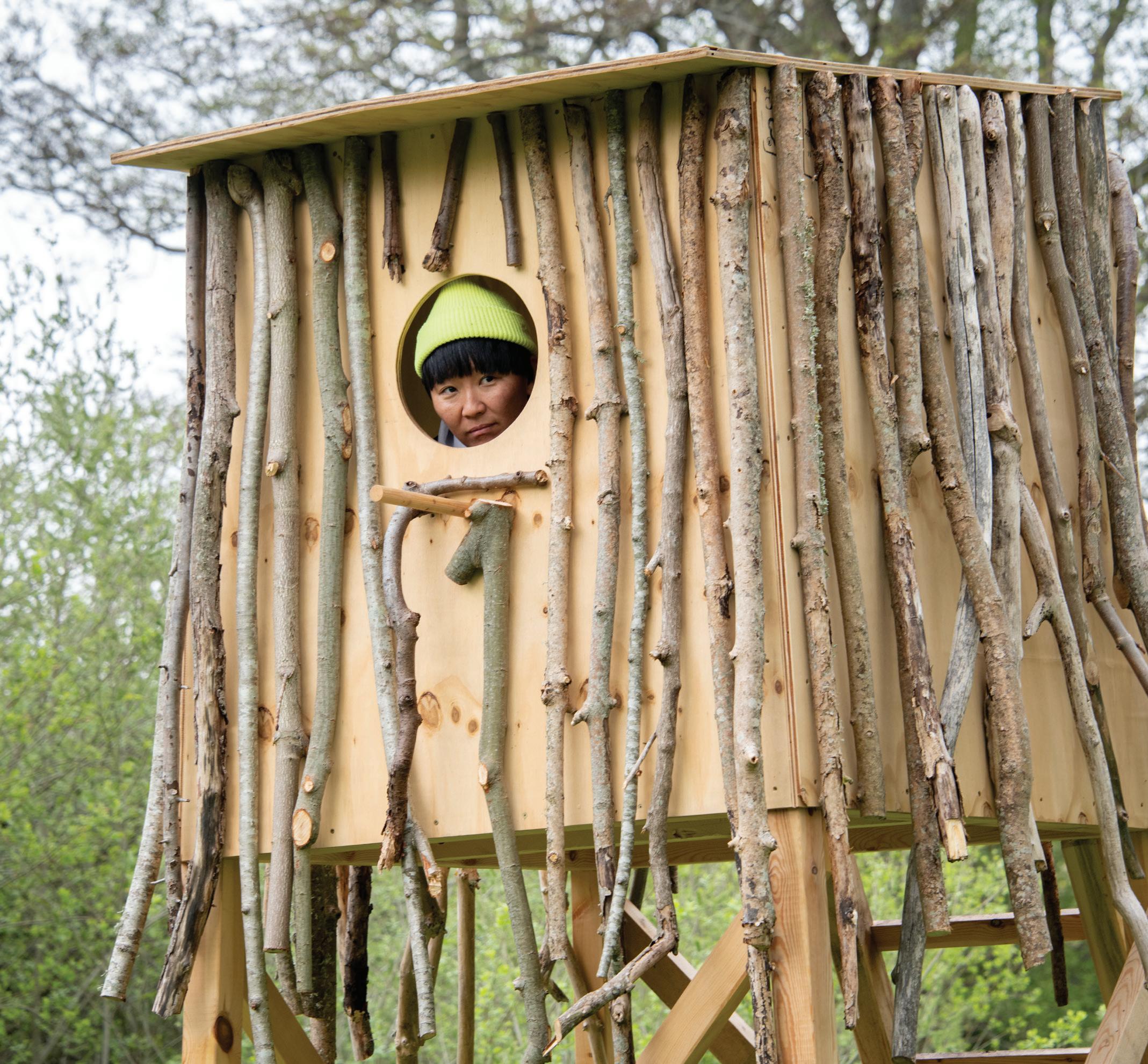 By the Gwangju News
By the Gwangju News
Gwangju has always been aiming to remember the struggle and sad history of the May 18 Democratic Uprising through aesthetic means. Since first being held in 1995, the Gwangju Biennale has been establishing itself as Asia’s oldest and most prestigious art exhibition, contributing to Korea’s contemporary art and introducing Korean art and its talented artists to the world.
This year, from April 7 to July 9, the Gwangju Biennale will host its 14th Biennale, showcasing works from 79 artists, half of which are new works that have never been exhibited previously. The theme “soft and weak like water” (柔弱於水) was inspired from Tao Te Ching, a classic Chinese text by Laozi. “soft and weak like water” refers to the power that brings change, not through immediate effect but from continuous endurance and gentleness, flowing through structural differences and divisions.1 It sends a message of hope for peace and democracy through various locations in the city, including Gwangju Biennale Exhibition Hall, Gwangju National Museum, Horanggasy Art Polygon (호랑가시나무 아트 폴리곤), Mugak Temple (무각사), and Art Space House (예술공간 집). Gwangju National Museum will showcase a ceramic collection, Horanggasi Art Polygon will feature arts exploring humankind and nature, Mugak Temple will feature meditative works on the nature of life, and Art Space House will run art projects and workshops.
Of the 79 artists, the Gwangju News is fortunate to have reached Anne Duk Hee Jordan, an established artist based in Berlin who will debut a suite of interactive robots at the Biennale. These newly designed robotic entities will be merged with immersive installations that developed out of Jordan’s continued fascination with marine life, technology,
sexuality, nutrition, and ecology. Our interview with the artist is as follows.

Gwangju News (GN): Hello and thank you very much for accepting our proposal for an interview. It is an honor for us to meet you! Could you please tell us a little bit about yourself, when you started being involved in the arts, and your professional background?
Anne Duk Hee Jordan: My name is Anne Duk Hee Jordan, and I am an artist but also trained as a chef and professional therapist for autistic kids. I also did my training as a rescue diver and freediver. I integrate all this still in my artistic practice (except the therapy thing). I think I always liked to build and install worlds around me, but it took me a while until I studied art. However, once I was committed, I could not stop.
GN: We understand that you are based in Berlin. What about the Berlin art scene made you want to move there?
Jordan: I moved to Berlin because of my studies. I always wanted to become a painter and studied in Düsseldorf. My landlords at the time were Anna and Bernhard Blume, the famous photographer couple in Cologne. As for why I moved to Berlin, Bernhard once told me, “Maybe it’s not about painting; it’s probably just that the city doesn’t want you.” He was right. So, I applied to the sculpture department at Berlin Weissensee and got in. After earning my Vordiplom, I left to finish up my studies at the Institute for Spatial Experiments with Olafur Eliassion. The end of the story is not that the Berlin art scene made me move there, it was Bernhard Blume [smiles].
GN: How has exposure to the Berlin (and European) art scene changed your approach to art?
Jordan: I have lived most of the time there, so I guess I am an assimilated artist.
GN: Coming from two different cultures – East and West – how do you think it influences your art and thoughts?
Jordan: I mean, that is a tough cookie to answer. I grew up in the West, but my DNA and all the rest of my molecules and matter are 100-percent Korean. (I did a 23andMe DNA test.) I was born in Korea, and I lived the first 3–4 years in Seoul but later got adopted in Germany. I cannot really remember much of my time in Korea. The only thing I know is that I always had special taste buds which obviously did not belong to Europe. So, I guess my culinary artistic practice is very much Asian, and my thoughts – who knows –they do what they want, whether they are in Europe or somewhere else in the world.
GN: Many of your artworks are installations incorporating an eclectic combination of nature and modern technology, many of them involving movement. Could you tell us what attracted you to this genre and what the nature-and-technology message is that is embedded in so much of your work?

Jordan: It comes from the same source called nature, and everything is related. If we think ecologically, we need to think circularly and without interruption.
All our resources, energy, inspiration, and medical research are from organic living matter. If I zoom out of my body and look at the universe, I assume I do not even exist in a larger scale. That is why I like movement, romantic machines, sculptures, and plants. That is why I create Artificial Stupidity, an ongoing robotic series of failing machines. These unintelligent machines, trying to reclaim their right to exist and through their failing gestures at trying to save the world, explain why we need more artificial stupidity in this world. But coming back to the question, everything is fluid, in constant movement, and related to each other. That is why my work builds up into a circle of constant movement.
GN: While many artists focus on one genre with limited materials, such as oil on canvas, your art genre, in addition to installations, ranges from photography to performance art. And your materials run the gamut from insects and plants to technology and machinery, large and small. Can you tell us where this incredible variety and uniqueness in materials and subject matter comes from?
Jordan: I use different methods, materials, and mediums in order to make the artwork
understandable, visible, and perceptual. Depending on what work I am engaged in, I start to do my research in order to understand what I am doing. It is never a fixed medium, nor a fixed approach. I try to be as flexible as possible and always challenge myself.
GN: When you are not busy creating art, what do you usually do in your spare time?
Jordan: The thing is my brain – I wish I could just turn it off for some time, but that is impossible, so I always create something (smile). Unfortunately, I do not live by the sea, but when I am there, I go freediving. Freediving is so incredible, silent, and relaxing. It is not a matter of how deep or how long you can be under water: It is a state of mind, a deep meditation. The moment you are in the water, the dive reflex starts, which is an amazing asset. You become a fish, your body changes, your heart rate drops, your organs get smaller and smaller, and you start to live longer. In the first month of a human embryo, the hands and feet are basically fish fins. Only one genetic defect could change all that. The same goes for our heart. In the development stage, the human heart has two chambers, the same as fish. Is that not amazing? I love to spend my time under water and be a fish, but I also know the power of the ocean, and I do not underestimate it. I was diving in Thailand at the time when the tsunami hit in 2004.
GN: Will this be your first visit to Gwangju? What is your hope by participating in this year’s Biennale?
Jordan: I am so looking forward to it, and yes, it is my first time. It is my first time after 43 years being back in Korea – crazy!
GN: Could you give us a “sneak preview” of what you are preparing to exhibit at the upcoming Gwangju Biennale?
Jordan: It will be a mirror universe, an underwater galaxy with inhabitants of the latest artificial stupidity robots. This includes five extraordinary soap bubble clone brains of James Lovelock and his master brain itself. Another protagonist created for this temple is The Godess of the Sea, a seaweed dancer who represents all life forms, from heaven to earth and from soil to plankton, which is accompanied by a Zen gong for Buddhist ghosts swarming in the temple, and a possibility for the visitors to meditate and contemplate with the cloned brains.
GN: Incredible! We are so looking forward to seeing your underwater galaxy at the Biennale when it opens in April. Thank you for this interview.
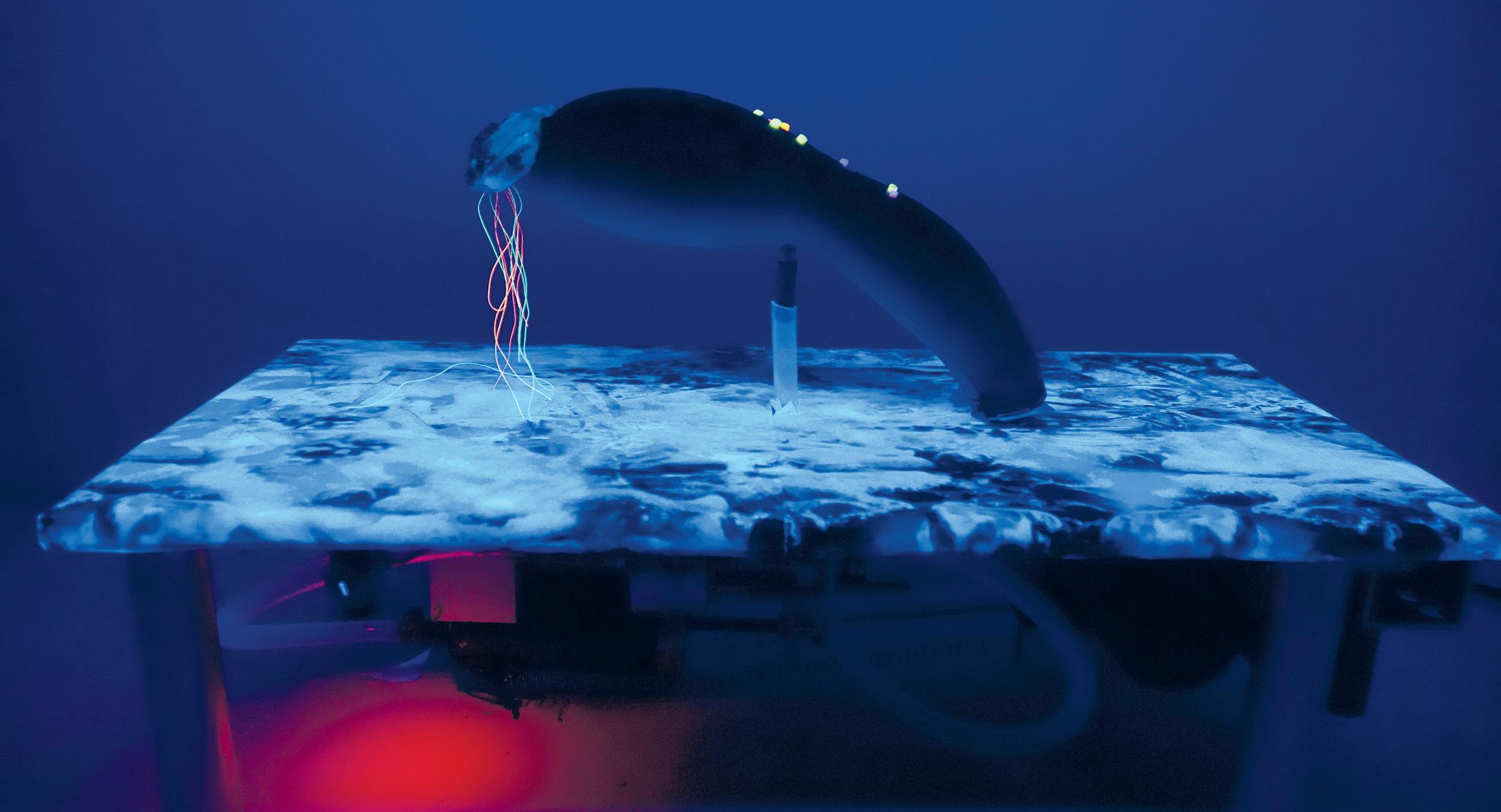
1 Lee, S.-K. (n.d.). The title of the 14th Gwangju Biennale is “soft and weak like water.” Gwangju Biennale. https://www. gwangjubiennale.org/en/Board/11012/detailView.do

Most people realize by the age of five or so that taking care of an animal is a lot of responsibility. Be it a cat, dog, rabbit, or hamster, it is necessary to feed it, clean it, and above all, not leave it abandoned in a cage in an amusement park for three years because you got tired of looking after it.

Unfortunately, Tongdo Fantasia Amusement Park in Yangsan did not get that memo and, bewilderingly, left a fully grown Bengal tiger believed to be named Hosooni in a cage by herself for three years after the amusement park closed. While it appears that there was someone providing the minimal level of care to the tiger so that she did not meet her untimely end, several people that visited the enclosure described the conditions as nothing less that appalling. The Gwangju News spoke with Jason Teale, a long-term resident of Korea who visited the amusement park and photographed the tiger. “When I first walked up to the tiger,” he said, “I was in utter disbelief. There was no one around, and yet there was a living tiger just... there.” He also mentioned that the tiger
seemed pretty docile (which may or may not have been from all that malnutrition and neglect).
Had it not been for a YouTube video by Ugly Lovely Media and a story by The Korea Times’ Jon Dunbar, this ridiculous situation might have just fallen into

obscurity. Fortunately, the coverage of this preposterous scenario garnered enough attention and moral indignation that the tiger was able to find a new home at Family Land’s Uchi Park Zoo, right here in Gwangju. While Teale was disappointed that it took so long to get the ball rolling on the transfer, his main hope is that the tiger can be helped and that she can live a somewhat healthy life at her new home.
Uchi Park Zoo is perhaps most famous for adopting former President Moon Jae-in’s Pungsan hunting dogs that were gifted to him by North Korean leader Kim Jong-un. Former President Moon’s decision to give up the dogs generated a lot of negative press and public backlash, but it is actually pretty difficult to find fault with his decision. Pungsan hunting dogs require a lot of care (more than an older gentleman could likely provide by himself), not to mention space and attention. As well, former President
Moon saw to it that the dogs would be looked after properly, and visitors to the zoo can enjoy seeing them when staff members take them out for their daily walks.
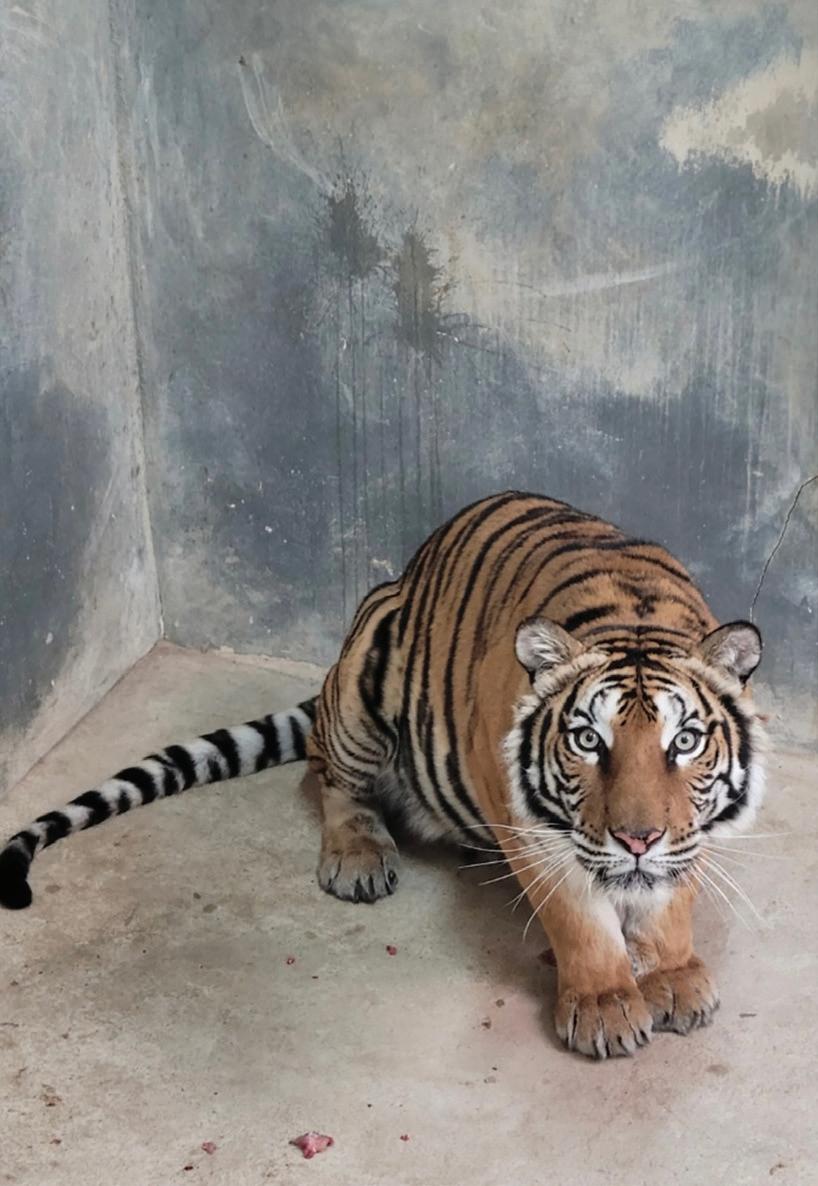
Uchi Park Zoo already has a number of tigers under its care, meaning it also has the specialized expertise required to properly care for these magnificent animals. This is a critical factor, since tigers occupy a very specific niche in their ecosystems and exist within narrowly defined ecological parameters. In other words, you cannot just throw a tiger a pack of hot dogs here and there and expect it to be okay.

The Gwangju News spoke to representatives at Uchi Park Zoo who were directly involved with the tiger’s care and said it was thanks to the direction of a great veterinarian (and a proper dosage of anesthesia) that they were able to successfully transport Hosooni to her new home. While she is not ready for public viewing quite yet (which probably has to do with her being abandoned in a godforsaken amusement park for three years), the staff reported that she is adjusting well, eating a healthy diet of chicken, and not experiencing any special health problems.
Having the skills and personnel to care for a tiger is only part of the battle, and there are still logistical challenges that are being slowly overcome. For example, since tigers (unlike lions) do not live in packs, it has been necessary to set up a special partition in the existing pens. The zoo staff assured the Gwangju News that even though Hosooni will be kept by herself, she will not feel lonely and will have many people nearby to look after her.

The people of Gwangju should be proud of Uchi Park Zoo for stepping in (and stepping up) to take care of this tiger. Hopefully, many people will visit the zoo to support its efforts and also to welcome Hosooni.
Not taking care of a household animal like a dog, as terrible as that is, is one thing. Taking a beast out of its natural jungle habitat, shipping it across the world, then letting it deteriorate in a cage for three years is willful neglect on a whole different level. Even for those who are not animal lovers or environmentalists, it is difficult to
not feel complete and utter disgust towards the individuals responsible for this shameful and absurd abandonment of a Bengal tiger. Their complete lack of foresight, combined with their wanton disregard for the life of a rare and beautiful animal, exemplifies avarice, exploitation, and misconduct along with an unhealthy dose of covering one’s own dirty backside and running away when the going gets tough.
To even the score, maybe the people responsible for this nonsense should lock themselves up in a cage for a few years to experience the agony that Hosooni has faced.
Not long ago, there was an exhibition titled Yi Soon (이순, 耳順) by the artist Heo Dal-yong at the gallery Art Space House. “Yi Soon” refers to the age of 60, when one’s ears become gentler, and one considers things more objectively, and therefore more easily realizes the meaning of things – this is according to Confucius.
I had had a chance to see Heo Dal-yong’s artworks before. So, I wondered how his art might have changed since then. I remember his painting of President Roh, Man Who Became a Mountain. Roh Moo-hyun (1946–2009) was president of Korea from 2003 to 2008. He was a human rights lawyer and activist before he entered politics, and he was known for his progressive policies during his tenure. He committed suicide by jumping from a cliff near his home. His passing was a great loss to many common people in the country.
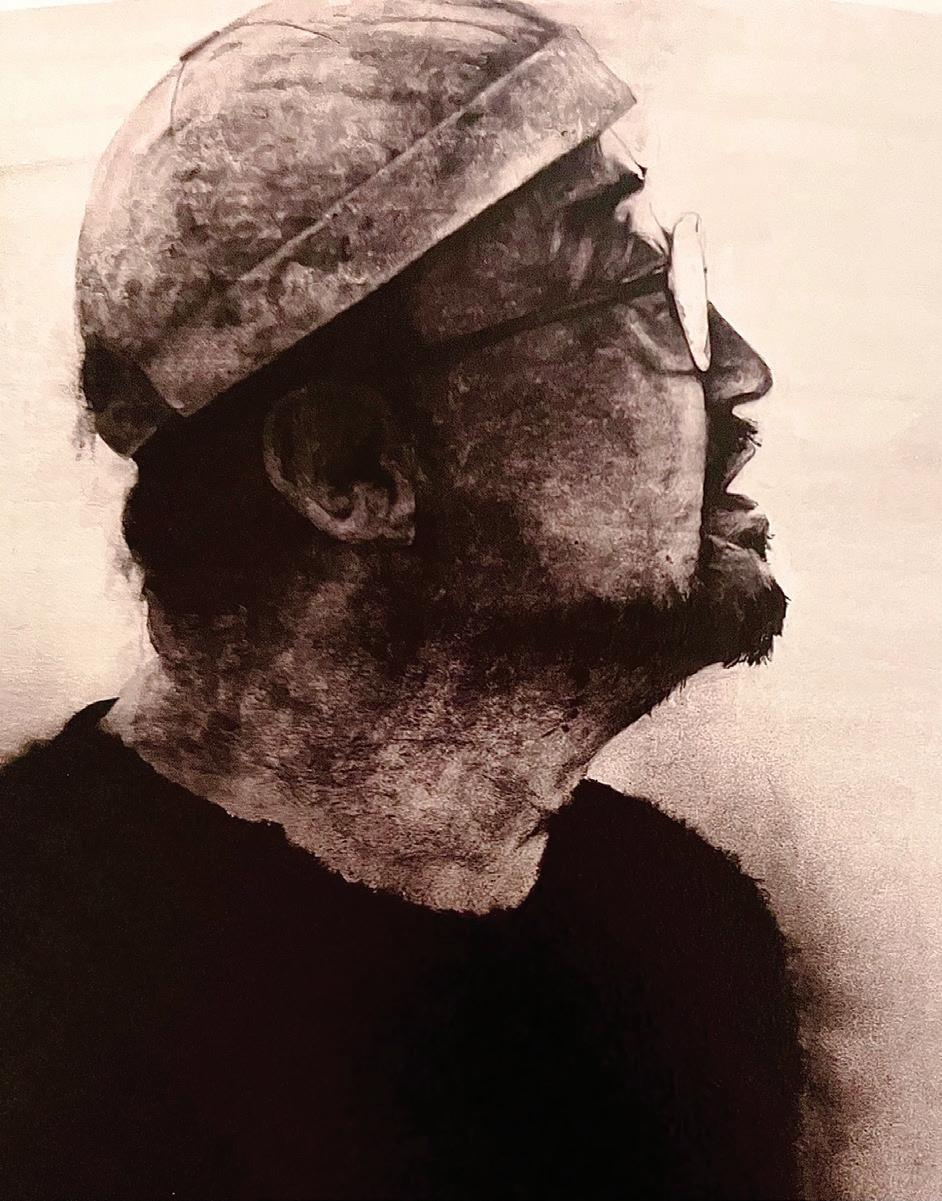
 By Kang “Jennis” Hyunsuk
By Kang “Jennis” Hyunsuk
As one who remembered Heo Dal-yong’s earlier style in art, I wondered what changes might have taken place in his art at the age of the “gentle ears.” When I saw a long, white, and narrow road running between the deep, dark mountains in one of his paintings, I was surprised that the painting was so dazzling even though it was painted in only black ink. I thought the painting well suited the term “Yi Soon.” This memory prompted me to ask him for an interview for the Gwangju News. However, before having that interview with him, I did my research and found some detailed information about the artist and his family tree.
Heo Dal-yong was born into the Heo family, which was continuing the line of the painting referred to as namhwa (남화). Namhwa is a style of painting that originated in China. It is also called “literary painting” because this style was mainly painted by Confucian scholars rather than by professional artists. So, it tends to value the spirit of the paintings.
In the late Joseon Dynasty, the great scholar and calligrapher, Chusa Kim Jung-hee (1786–1856) accepted Heo Ryeon (1808–1893) as his disciple and recognized his painting as the best in Joseon. Heo Ryeon (1808–1893) was called the master of namhwa painting in the late Joseon Dynasty. His painting style was handed down to Heo Hyeong (1862–1938), Heo Gun (1908–1987), and their descendants. Another branch of the Heo family also has many artists in its ranks. Heo Baek-ryeon (1891–1977) of Gwangju fame and his younger brother, Heo Haeng-myeon (1906–1966), along with their descendants, are in this group of the Heo family bulging with artists. It seems rare in this world to have dozens of artists from a single family line in just 200 years. Armed with this and additional information, I set out for my rendezvous with artist Heo Dal-yong.
Jennis: Thank you for granting this interview. I heard your grandfather and father were both traditional ink painting artists, and I imagine you naturally embraced becoming a painter in your childhood. When did you start painting?

Heo Dal-yong: Heo Haeng-myeon (1906–1966), the younger brother of Heo Baek-ryeon, passed away when I was a child, so I do not have a lot of memories of my grandfather. And from observing my father, Heo Dae-deuk, I never dreamed of becoming a painter myself because I felt that life as an artist was too difficult to make a living and have a family. Then, when I was in middle school, I felt that I was not very interested in studying at school. So, I told my father that I would study painting, and I started studying painting from the disciples of Heo Baek-ryun, my great uncle.
Jennis: What did you study in the beginning?
Heo Dal-yong: At first, I studied the Four Gracious Plants (plum blossoms, orchids, chrysanthemums, and bamboo) of oriental painting, and I enjoyed it very much.
Jennis: You entered the College of Art at Chonnam National University. What was your college life like?
Heo Dal-yong: There was an art club at the high school I attended, and the members of the art club were given a scholarship. So, I started my life in the art club and entered Chonnam National University
as a Korean painting major in 1982, the same year that the College of Art was founded. As soon as I entered, the university was engulfed in a chaotic atmosphere. Park Gwan-hyun, the former president of Chonnam University, who was a leader in the protests in Gwangju in May, 1980, died in prison in 1982. The students of Chonnam University and the citizens of Gwangju were shocked. There was a protest every day to get to the bottom of what caused his death. And I had a college life of drinking makgeolli rather than studying.
Jennis: Since when did you start painting in earnest? Heo Dal-yong: When I was in my senior year of college, my father had a stroke, and I had to do my army service. When I finished my military duty and returned to college, I met Professor Lee Tae-ho, who was teaching art history. Due to his influence, I joined the art group Gwangju Chonnam Artists Association and started an art movement. From then on, I have thought that I should paint my own paintings. So, I studied the works of the best painters of the Joseon Dynasty, such as Gyeomjae Jeong Seon (1676–1759) and Danwon Kim Hongdo (1745–1806), as my painting “teachers.” When
I got stuck with my painting, I looked to them for inspiration. And I held my first solo exhibition in 1997 to highlight studying on my own.

Jennis: In your early landscape paintings, you depicted ordinary people’s daily life, such as a farmer working in the field, not that of people who leisurely enjoy nature. Is the child standing with a brush in one of your paintings your son?
Heo Dal-yong: Yes, that is right. My son also picked up a brush among the various things placed in front of him at his first birthday party. [In Korea, at the first birthday party, there is the tradition of predicting the baby’s future from what the baby selects from among various objects placed in front of him. For example, money signifies future wealth, a spool of thread represents longevity, and a pencil indicates becoming a scholar.]
Jennis: There is the White Night series among your artworks. I wonder why you named it “White Night”?
Heo Dal-yong: When I was working in civil

organizations, I did not have time to pick up my brush during the daytime. I thought that an artist who did not hold his brush could not be an artist. So, I went to my studio on the outskirts of Gwangju late at night and painted. Sometimes I worked till dawn. That is why there are so many works of mine with White Night as their title.
Jennis: What artworks have you created in relation to social movements?
Heo Dal-yong: When I was working in various civic organizations, I depicted social issues in a straightforward way. But now I want to express my own sensibility. A few years ago, when I stopped by the National Army Hospital, a May 18 historical site, I spotted the beautiful tree leaves outside the window of the building where wounded citizens had been dragged and locked up during the May 18 Uprising. I empathized with the injured citizens and how they felt when they looked out that window. I painted this feeling in Window of May. My expression has changed from the direct way, like painting blood and death, to delivering feelings in a more indirect way. It is a different way of telling stories about May 18.
Jennis: What kind of paintings have you done on other social issues?
Heo Dal-yong: I have painted social issues such as the candlelight vigil against the incompetent and corrupt government with the painting The Blue House with Lights Off. And I have expressed birds as the power of the people, as in the Hitchcock film The Birds. Birds are small individually, but when they gather, they can pose a fearful threat to a huge plane.
Jennis: A few years ago, you held an exhibition with only cat paintings. How did it come about that you began to paint cats?
Heo Dal-yong: Except for my son’s childhood painting, I think it was the first time I had painted close-up objects with such affectionate eyes. I was attracted to cats as a subject with their clear and big eyes, and various expressions in those eyes. The process of making friends with stray cats was also amazing. These days, I often paint cats.
Jennis: I think this could provide an opportunity to broaden the public audience who enjoy your paintings. What plans do you have for future painting?
Heo Dal-yong: I consider that ink-and-wash painting is the eternal assignment that I have to work on. However, as a member of this society, I also want to do something helpful.
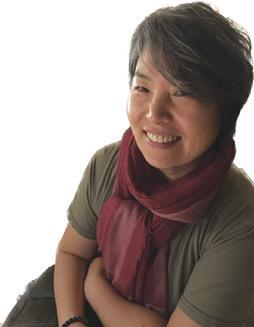
Jennis: Your contributions to society have already been great! Thank you for this most interesting interview.
Heo Dal-yong’s historical paintings have played the role of drawing attention to social issues from all corners of modern society. At the age of 60, he says that he wants to create paintings that he can talk with for a long time. I am a big fan of the inkand-wash paintings of Heo Dal-yong, who carries on the family tradition of working in the arts, and I am looking forward to soon seeing his cat painting exhibition.
2023 Becoming Sixty, 耳順; View from the Window (Art Space House, Gwangju)

2022 Heo Dal-yong Invitational Exhibition
(Starry Night Street Art Gallery, Gwangju)
2021 Heo Dal-yong Invitational Exhibition (KimNetGwa Gallery 3, Gwangju)
2020 Loving Cats, 猫情 (Art Space House, Gwangju)

2019 Black & White (S.A.F. Cube Gallery, Gwangju)
2018 The 9th Memorial Requiem for Mr. Roh, Man Who Became a Mountain (S.A.F. Cube Gallery, Gwangju)
2018 Private Exhibition (G&J Gallery, Seoul)
2017 Black & White (GMA Geumnam Street Branch, Gwangju)
2016 Invitational Exhibition (Gallery Nori, Jeju)
Jennis Kang is a lifelong resident of Gwangju. She has been doing oil painting for almost a decade, and she has learned that there are a lot of fabulous artists in this City of Art. As a freelance interpreter and translator, her desire is to introduce these wonderful artists to the world. Instagram: @jenniskang
William Urbanski: Thanks for taking the time to do this interview! As the only Dutch academic researcher in Gwangju, could you please tell the readers a little bit about your academic and professional background? Besides a long list of academic achievements, you have also been heavily involved in industry, correct?
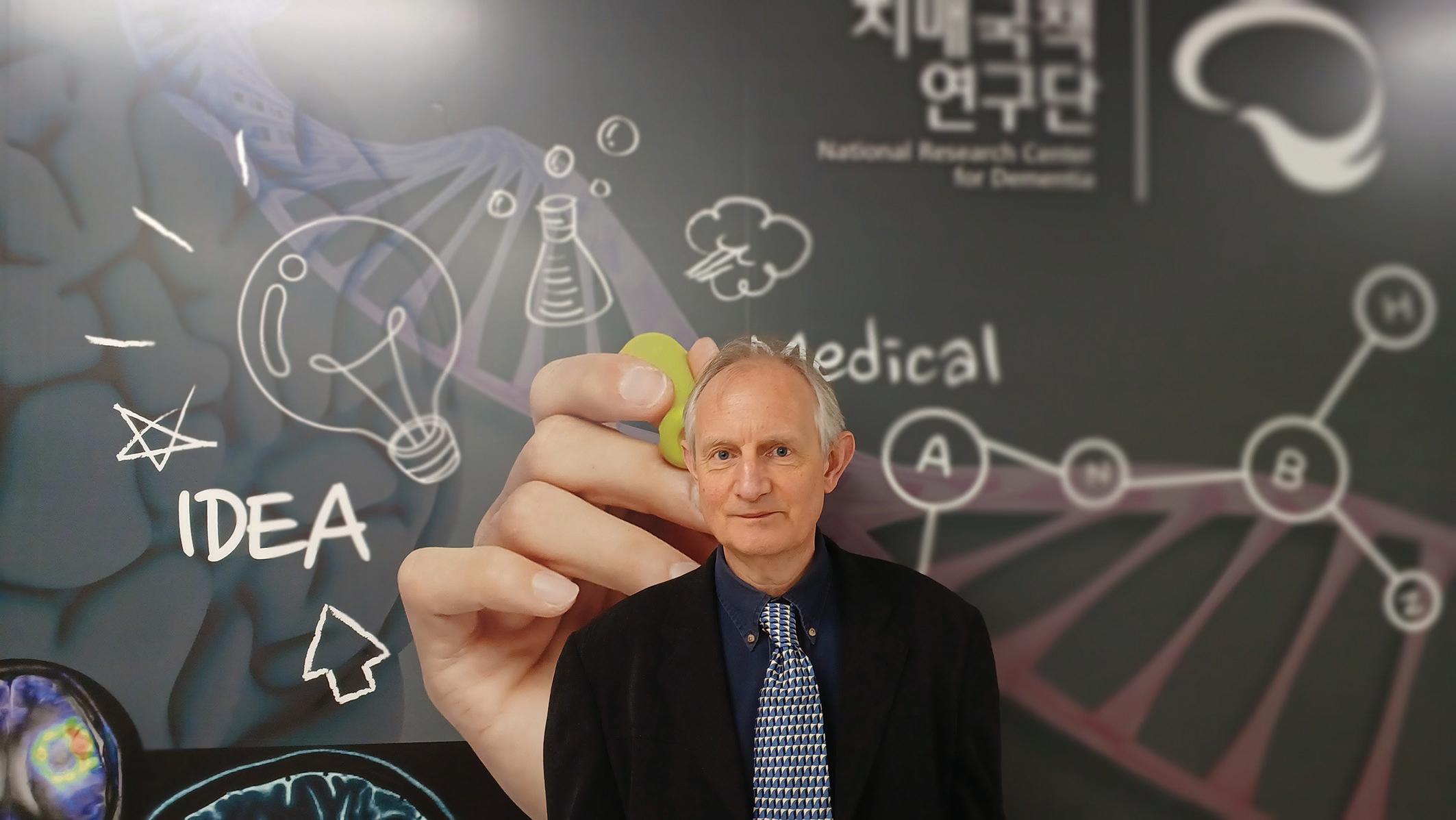
Jan te Nijenhuis: First of all, thank you for doing this interview with me. It is always an honor to be interviewed because it shows that people are interested in your work. It is great to be in Gwangju. I studied at the University of Groningen, a beautiful, old medieval city in the north of the Netherlands. I had two specializations: personality psychology and industrial and organizational psychology.
Every human being is unique – even twins – and personality psychology supplies the terminology to describe this uniqueness.
I/O psychology is about running organizations well, and I specialized in personnel selection: You have ten applicants for a position, and how do you choose the one that will perform the best quality of work for the organization, so that the profit will be highest and the person is most satisfied in his work? Scores on IQ tests do the best job. So, both in my theoretical studies and my applied studies in psychology, the IQ test was the most important.
I have always been interested in combining
theoretical research and applied research, and I have always had a strong focus on IQ testing. I worked for the Dutch government, namely Dutch Railways, and the Royal Dutch Armed Forces, which included a large project for the Royal Dutch Military Police, and I did a lot of consultancy work in industry, including the National Dutch IQ Test on TV and making an IQ test in the form of a video game. The interesting thing about intelligence is that it is linked to thousands of important phenomena, so you can do research on many topics, which I did. A specialty of mine is taking existing datasets from applied research and testing fundamental theories on them; that way, I do not have to spend enormous amounts of time collecting research data.
I have won several prizes for my research. I collaborated with people from around the world, so I have more than 200 different co-authors. I have many successful collaborations with Northeast Asians: Koreans, Chinese, and Japanese; it is a winning combination for me!
William Urbanski: Around 2013 you achieved a level of fame and notoriety worldwide thanks to an academic paper you wrote about (and I am paraphrasing here) the general decline in people’s intelligence since the Victorian era. Could you tell us about that?
Jan te Nijenhuis: I am very proud of that paper. It resulted in hundreds of thousands of tweets and hundreds of thousands of reactions on the internet and extensive coverage in newspapers, weeklies, TV, and radio. I was interviewed for Dutch, French, German, and US TV.
What is the background? Before 1800, life was harsh, and rich people had twice the number of surviving children than poor people. Many times, half the children would die, whereas the percentage is now smaller than one. It was brutal. But after 1800, the Industrial Revolution brought wealth, and highereducated people had slightly fewer children than lower-educated people. Because intelligence is highly heritable, the higher-IQ parents could pass on their genes for higher intelligence to fewer children, and the lower-IQ parents could pass on their genes for lower intelligence to more children. The effects are very small: only one IQ point per ten years. But we proved that it adds up: Over a period of one century and a half, the mean intelligence in the Western world
declined by 14 points, which is a gigantic effect. Having a good number of highly intelligent people is crucial for society. Scientists have to be very clever, and the top people in business also have to have very high IQs; it is very difficult to be a successful businessman. With the mean intelligence strongly declining, the percentage of very clever people dramatically decreases. You would predict that people now would have produced far fewer important inventions than our forefathers, which is exactly what happened. Correcting for the fact that we now have much bigger populations, we only have 15 percent of the big discoveries of the Victorians.
Our brains are less good at processing information than 150 years ago. We still build upon the legacy of fantastic inventions made by the very clever Victorians.
William Urbanski: I definitely agree that people’s intelligence is getting lower, so it is nice to see that theory backed up with evidence. In your study, you looked at the correlation between reaction times and IQ. Could you explain how that works?
Jan te Nijenhuis: Intelligence is about your brain processing information. Clever people process that information quickly, and dull people process that information slowly. Many people are familiar with classical IQ tests, for instance, for determining which school type is best for them or for entrance into the Armed Forces. In some IQ tests, you have to work with words, for instance, how many difficult words do you know? Or you are tested about the breadth of your general knowledge; for instance, which Korean admiral scored victories against the Japanese navy in the Imjin War? Or you have to play with numbers: How much is 327 times 16? Or you have to rotate figures in space. By the way, Koreans are the best in the world with spatial rotation! Then you add up the scores on all the tasks, and you have an overall IQ score, indicating a general ability to solve problems.
However, there is an older tradition from the nineteenth century to measure how well your brain processes extremely simple information, the so-called simple reaction time. For example, a light comes on, and you have to push a button as quickly as you can. This takes you less than one second, and people with a good brain do this much faster than people with a less good brain. Like with traditional IQ tests, there are also all kinds of simple reaction time tests. When
you combine ten different simple reaction time tests, you get a score of general simple reaction time. And several studies have shown that the total score on an IQ test and the total score of simple reaction times hang together perfectly – they measure the same thing: the brain’s ability to process information.
So, in our 2013 study, we used old reaction time measures from the 1880s devised by Francis Galton, the brilliant cousin of Charles Darwin. Our study was very technical and required expertise in very different fields, but it was scrutinized by experts and got published in a top journal.
William Urbanski: How did it come about that you came to Chosun University as a full-time researcher? I understand that before attaining your current position, you had a couple of shorter stays in the city. Jan te Nijenhuis: How did I end up more than 10,000 kilometers from home? That is an interesting story. To make some extra money, I also work as a science writer, often interviewing scientists whose work I enjoy reading. In 2006, I was asked to interview a certain Dr. Kun Ho Lee, a brain researcher who found some brain areas that were strongly linked to scores on IQ tests. The study was published in a top journal, and I was impressed, so I interviewed him by email. After the interview, we kept in contact by email, and we published several papers together, often based on Korean data. We met for the first time at a conference in Madrid, Spain, where I also met his wife and young daughter, and later he spent a day with me in Amsterdam, where we made a tour by boat through the canals. In 2013, he emailed me: “Jan, I received a grant of 50 million euros, and I can build my own research center on Alzheimer’s research.” I was happy my Korean friend was so successful. In 2015, he invited me to give a lecture on my research at Chosun University. On my first trip to Korea, for one week, I was treated like a king, with a stay in a five-star hotel and fantastic dinners, and at the end was invited to come work in Gwangju. After that, I worked in Korea three times, but always for only short stints of two months. In 2019, I started working on longer contracts, and I now even have an Indian post-doc working with me.
William Urbanski: Coming to Korea as a Westerner always poses cultural and linguistic hurdles. From a research perspective, could you talk about the

specific challenges you face in Gwangju and at Chosun University? Maybe you could tell us some of the positive aspects as well?
Jan te Nijenhuis: It is really a pleasure working in Gwangju. The Koreans have the highest mean IQ score in the world: 107. The people are superbly trained, work very hard, and they always help me if information is only available in Hangul. Also, the undergraduate students all want to be the best in the class; this is very different from many Amsterdam students that try to get away with the least amount of work possible and do not mind producing sloppy work.
The Dutch are very individualistic, but the Koreans do everything in groups. Even the students on campus often walk in groups, at a small distance from each other. I once had a technical question for my colleague on whether I could take a statistical shortcut that would save me two hours of work. Then we had a group discussion with five people that took two hours. So, ten man-hours of work to save me two hours of statistical computations! But, at least there was consensus!
I am ashamed to say that after all these years, I still speak almost no Korean. I was raised bilingually, and I am a polyglot busy learning my seventh language, namely Portuguese, which takes up quite a bit of my free time. Adding language number eight is a bit of a time challenge. I want to learn more about Korean culture, and speaking the language is essential.
William Urbanski: At Chosun University, you are researching certain aspects of Alzheimer’s disease. Please tell the readers how this connects to your field of expertise in theoretical and applied psychology. Jan te Nijenhuis: Alzheimer’s is a nasty brain disease. The nerves in the brain are slowly rotting away until they die. It becomes increasingly difficult for the brain cells to communicate with each other, so the processing of information by the brain slows down dramatically. This means the scores on IQ tests get lower and lower, and even the simplest tasks previously become too difficult.
Well, I do not have a background in medical biology, but I know a lot about intelligence and especially how to test it. I worked a lot in personnel selection, where the IQ test is the best instrument to help you select who will be the best worker for a company. I also worked a lot on the development of new intelligence tests. I now apply these skills to intelligence-related topics in biomedical research. For instance, a hot research topic is finding the areas of DNA that are responsible for IQ scores. My Korean colleagues have IQ scores of the Gwangju elderly, and also DNA scans at the level of the smallest units, the so-called single nucleotide polymorphisms, or SNPs for short. I work on several projects where I try to find the SNPs for intelligence using specialized techniques from theoretical intelligence research.
These are always collaborations; I know a lot about intelligence testing, and my Korean colleagues know a lot about medical biology and SNPs. It is specialized work, and I am learning something new daily. The switch from personnel selection at the Dutch Armed Forces to Alzheimer’s research at Chosun University may seem drastic, but for me, it works well. It is all about intelligence.
William Urbanski: Where are you getting the data for your current research?
Jan te Nijenhuis: My Korean colleagues have built a fantastic database with everything that predicts the onset of Alzheimer’s disease: genes, brain scans, blood scans, brain fluids, history of illnesses, and intelligence scores. All the data come from the elderly in Gwangju and its surroundings. There are now more than 10,000 included in the database. Most of them have no signs of cognitive illness; there is a group with mild cognitive impairment, and
the smallest group consists of people with varying severity of Alzheimer’s disease. There is a whole team of qualified people collecting the data here in Gwangju. Some of the elderly also participate because they get free medical check-ups. Collecting all the information costs a pretty penny, but the elderly pay nothing.
This unique database is used for collaborations with researchers from all over the world. For instance, some of the DNA samples are now scanned in the USA with the most powerful scanners in the world, so that we will have information on 100 percent of the DNA. But I must say that notwithstanding the billions invested in Alzheimer’s research, it is still a mysterious disease.
William Urbanski: To conclude, what are the biggest positives about living in Gwangju and being a researcher at Chosun University?
Jan te Nijenhuis: On the weekends, I take long walks around Mudeung-san; we have no mountains in my country, so this is all new to me. The trips help me to remain relaxed, physically fit, and creative, which is important for a researcher. It happens often to me that when I take a short break, people want to have a chat with me and offer me all kinds of food. The Gwangju people are amazingly friendly.
I very much enjoy Korean food – all the banchan (반찬, side dishes) make every meal feel luxurious. In Korea, I got into the habit of eating fermented food at every meal. Very good for the bacteria in your gut, which help you stave off infections. But I miss goat cheese, herring, sardines in olive oil, and one-liter buckets of ten-percent-fat Greek yogurt!
I think it is good for the Korean research culture to have contacts with researchers from countries with much longer research traditions. I have already set up all kinds of collaborations with Western researchers, analyzing the data in the big Gwangju Alzheimer database. I hope that in the near future, I will not be the only Western researcher on campus!

 By Umesh Mansukhani
By Umesh Mansukhani
Kim Dae Jung Convention Center, which opened on September 6, 2005, is on an international scale, a state-of-the-art exhibition convention center with 40,046 square meters of exhibition floor area, a total of 29 conference rooms, and a 3,000-seatcapacity multi-purpose hall. On the first floor there is a “Kim Dae Jung Hall” in honor of the late President. It consists of books, photos, gifts, souvenirs, pledges, certificates, and writings to honor the achievements of former President Kim Dae-jung, who devoted his life to the promotion of democratization, world peace, and human rights.
Gwangju Metropolitan City Hall is also in the Sangmu District and has a large area of 94,000 square meters, most of which is used as an outdoor plaza. There is a lawn plaza, an outdoor music hall, and a rose garden where various performances and events are held. Every summer, the grass plaza is opened to be used as a camping ground, and every winter an outdoor skating rink can be enjoyed by the people.
Sangmu Station is an underground station of Gwangju Metro Line 1. After exiting from this station, one can visit the following tourist destinations: Uncheon Reservoir, Sejong Outlet, Lotte Mart, Mugaksa Temple, City Hall, Arts Center, Chipyeong-dong, Peace Park, and Kyobo Bookstore. The commercial area around Sangmu Station consists of restaurants, coffee shops, bakeries, convenience stores, hotels, banks, night clubs, and pubs.
Sangmu Citizens’ Park has got a large square where, every Friday, a traditional market is opened by the farmers who sell their products such as vegetables, fruits, fresh fish, Korean side dishes, and fresh meat directly to the people at reasonable prices. There are also ready-made varieties of delicious foods, and it is fun to look around after one has worked hard during the week.
Sejong Outlet, located above the Sangmu Station, is a large shopping paradise where one can buy famous high-end local and foreign brands at prices 25–75 percent cheaper than usual (excluding some items) 365 days a year. Good products from 130 famous brands with proven reliability and product quality can be found in the stores here. Sports clothing, women’s wear, men’s wear, outdoor clothing, golf wear, casual wear, baby/children’s clothes, lingerie, shoes, bags, and accessories can be purchased here. Brands such as Crocs, Prospecs, FILA, Renoma, Spider, Mizuno, Kolon Sports, Under Armour, Nike, Adidas, Papageno, Valencia, Olivia Lauren, Calvin Klein, Mako, TBJ, Missha, ABC Mart, Puma, and Dynafit can all be found here.
Sangmu District has got a variety of famous restaurants offering delicious food, too. So, check
out the restaurants to satisfy your hunger. Numerous notable restaurants (and their cuisines) are on offer here, including Mudeung
Wang Katsu (king pork cutlet), Shinjukkumi (octopus cuisine), Sangchu Ttwigim (fried octopus wrapped in lettuce), Sanil Neungi (mushroom chicken soup), Wondumak (raw beef), Yukjeon Hanok (yellow croaker), Gungjeon Kimchi Jjige (pork-kimchi stew), Daesoyang (grilled pork giblets), and Chang Baeksan (lamb skewers). You will find yourself coming back to these restaurants over and over again.
Sangmu District has the largest number of traditional bakeries in Gwangju. The Mareuk Bakery smells like butter and is famous for bread and scones. You must visit and try a few other reputed bakeries such as Dasbrot (vegan), Lala Bakery, Neulis Neulis Gwajajeom, and The Geonganghan Ppang for their delicious roll cakes, sandwiches, and birthday cakes.
Coffee was introduced in Korea during the Joseon era. During the reign of King Gojong (r. 1863–1907), the twenty-sixth Joseon monarch, coffee was served to the king and other high-ranking officials and diplomats in the palace. In Sangmu, the traditional coffee shops are Cockle (for espresso and con panna), Slyfox (with its Sherlock concept interior), Espresso Sumuk, Sixbox, and Tea Room Jade.
Sangmu is also a financial district where all the major banks and investment firms are located. For your banking needs, one can visit Hana Bank, Kookmin Bank, Woori Bank, NongHyup Bank, and Shinhan Bank. For one’s investment requirements, approach the stock analysts at Samsung Securities, Mirae Asset, NH Investment, KB Securities, and SK Securities.
If you plan to stay a while, Sangmu District has got the best lodging and boarding facilities. There is a large variety of branded and boutique hotels here, serving lavish buffets for breakfast, brunch, lunch, and dinner. To name a few, visit the Ramada Plaza, Holiday Inn, D’yoo Hotel, Hotel Stay 53, and UTOP boutique hotel.

In order to secure medical insurance coverage, do visit the office of the National Health Insurance Service in Sangmu. Nearby there is Aladin, the largest second-hand store selling English books and magazines at very low prices. To get to all the aforementioned places, nearby subway stations are Uncheon Station and Kim Daejung Convention Center Station.
While I was enjoying the sights and smells of Sangmu, I found many youngsters in their teens around me. As I kept asking for directions to find my way around, many offered to help. I was surprised to see that nowadays, a majority of the young boys and girls can communicate in English. I would like to mention one lovely lady, Miss Shin Hyun-soo, who took me around showing me the sights of the vibrant Sangmu District.
To conclude our exploration of Sangmu, I will end with two inspiring travel quotes:
“Live your life by a compass, not a clock.” – Stephen Covey
“Travel is never a matter of money, but of courage.” – Anonymous.
Umesh Mansukhani is from India and is a freelance English tutor. He loves traveling, playing ping-pong, and watching Korean dramas.

 By Isaiah Winters
By Isaiah Winters
Sunchang County’s been on a roll lately in terms of tourism promotion. The county boasts a pair of suspension bridges at Gangcheon-san and Chaegyesan, plus the new zigzagging boardwalk up Yonggwol-san. The county’s tourism crown jewel is probably its hanokinspired Gochujang Village, adjacent to which is the new Sunchang Fermentation Theme Park (순창발효테마파크), which is about the most Jeolla pair of tourism facilities imaginable.
The latter two sites are backdropped by Ami-san, a boulder-studded promontory fixed with vertigo-inducing staircases that somehow nobody ever seems to notice. I hiked its 515-meter summit on a whim recently and loved it, returning just a week later with the missus so we could gasp our way to the top together in full StairMaster
misery. (As they say, misery loves company.) Down in one of Ami-san’s bucolic valleys is an even less-noticed haunt – an abandoned chapel and hanok affiliated with the Unification Church, otherwise known as the “Moonies.” As this is a “Lost” article, we’ll of course hyperfocus on these disregarded sites, which I’m sure county officials won’t appreciate.
Ami-san is somehow both Sunchang County’s most visible mountain and its tourism black sheep. It’s located right along Highway 12, so if you’ve ever gone that route from Gwangju to Jiri-san, or even further on to Daegu, you’ve surely seen it. It’s even got the Gangcheonsan Rest Stop (강천산 휴게소) right at its base, which should make Ami-san the county’s most easily accessible tourist destination – except it isn’t. On our way down the mountain, the missus and I had a rough time fighting through thorn bushes and other undergrowth to reach the rest stop, only to have the providential staircase we stumbled upon roped off at the bottom. Rather than encourage hikers to park at the rest stop, grab supplies for the hike, and then return to the rest stop tired, thirsty, and hungry after an excellent trek, the owners seem to want visitors to have no connection to the mountain whatsoever. Hell, they didn’t even use the mountain’s name for the rest stop itself.


A further irony here is that the rest stop is decked out in new vinyl window decals advertising the county’s many excellent tourist sites – basically everything mentioned in the opening paragraph of this article. Among those many decals, Ami-san is nowhere to be found. What we found firsthand on the mountain was quite impressive, however. On our trip, we spotted a half-dozen giant vultures circling the valley below in search of roadkill and other carrion. While hiking in Honam, I’ve seen giant vultures fly solo or in pairs many times, but never six at a time. This suggests there’s a lot of carcasses to feed on in Sunchang County, for whatever macabre reason. But these giant birds don’t stay for long, as they only fly down from Mongolia and Manchuria to winter in Korea’s warmer climes before returning sometime in spring. The Californian in me always finds them riveting, having been instilled with a reverence for the critically endangered California condor since elementary school.
Another temporary feature of the mountain which endears me to it is a stout, old man I call sanshin (산신, mountain spirit). He’s been up at the top both times I’ve hiked the mountain this spring, sitting alone in a small observation booth. From there, he keeps an eye on the valleys below for any fires

that flare up, often due to farmers incinerating their garbage. When a fire does occur, he radios into the fire department and keeps them updated on the situation. This he does as a retirement side gig during the driest parts of the year when forest fires are most likely. He collects minimum wage for his efforts, which amounts to about two million won per month. It’s a far cry from the salary he used to pull at the Ministry of Justice, but as he loves hiking and has property inherited from his parents down in the valley below, it’s a pretty convenient side hustle that keeps him healthy. What’s more, he maintains a social life in this way by talking the ear off anyone who reaches the peak, which is why I know so much about him.
Descending from the mountain for the remainder of this article, we’ll finish in a crescent-shaped village that looks out over rice paddy grids in the shadow of Ami-san. This village is home to a unique pair of religious structures: an abandoned chapel and hanok associated with the “Moonies.” The chapel façade is made of an odd, billowing brick style that reminds me of a cloud – the centerpiece of which is the Unification Church’s controversial logo: essentially a Japanese “rising sun” flag encircled in red. The church’s late leader, Moon Sun Myung,
had an interesting upbringing in what’s now North Korea, which he left to study electrical engineering in Japan in 1941. He returned to Korea in 1943 and later wound up imprisoned in a North Korean labor camp, presumably for his involvement with Christianity. UN soldiers would go on to liberate the camp in 1950, after which Moon made his way to South Korea, where he began his teachings – that is, if Wikipedia is to be believed. What’s for certain is that the Unification Church’s “Moonie” nickname is derived from its leader’s surname. Oh, and they hold mass weddings that marry off thousands of couples whose marriages are arranged through the church. If you’re curious to know more, YouTube’s got everything in excruciatingly awkward detail.
The chapel doesn’t contain much of interest anymore, though the stage is worth a mention. It’s still got a hefty, wooden donation box (헌금함), a bulky pulpit bearing the Greek alpha and omega symbols, plus a gaudy chandelier – all framed by a plush, goldtrimmed velvet curtain. Enveloped in such kitschy elegance, it’s not hard to imagine the days when church leaders used to break out the elaborate robes and glitzy crowns often seen in “Moonie” religious ceremonies. Moving on to the large hanok out back, the first thing you’ll notice is the porch, which is strewn with books on Korean history and
philosophy, some of which have been overtaken by vines creeping across the floorboards. The hanok is impressive for both its size and condition: It’s got enough headspace inside for a large attic above the main room held up by thick, sturdy beams that appear to still be in great shape. Adorning nearly every wall is a different picture of Mr. Moon and his wife, known as the church’s “true parents” (참부모). The best find inside is a scrapbook featuring news clippings and photos from the church’s more notable events, often those held abroad. If you’re interested in seeing the chapel and hanok in detail, you can visit the Lost in Honam YouTube channel for more.
So, there you have it, readers. Sunchang County has many unique sites for visitors that aren’t always worthy of a tourism billboard or rest stop decal. Have fun finding more of your own.
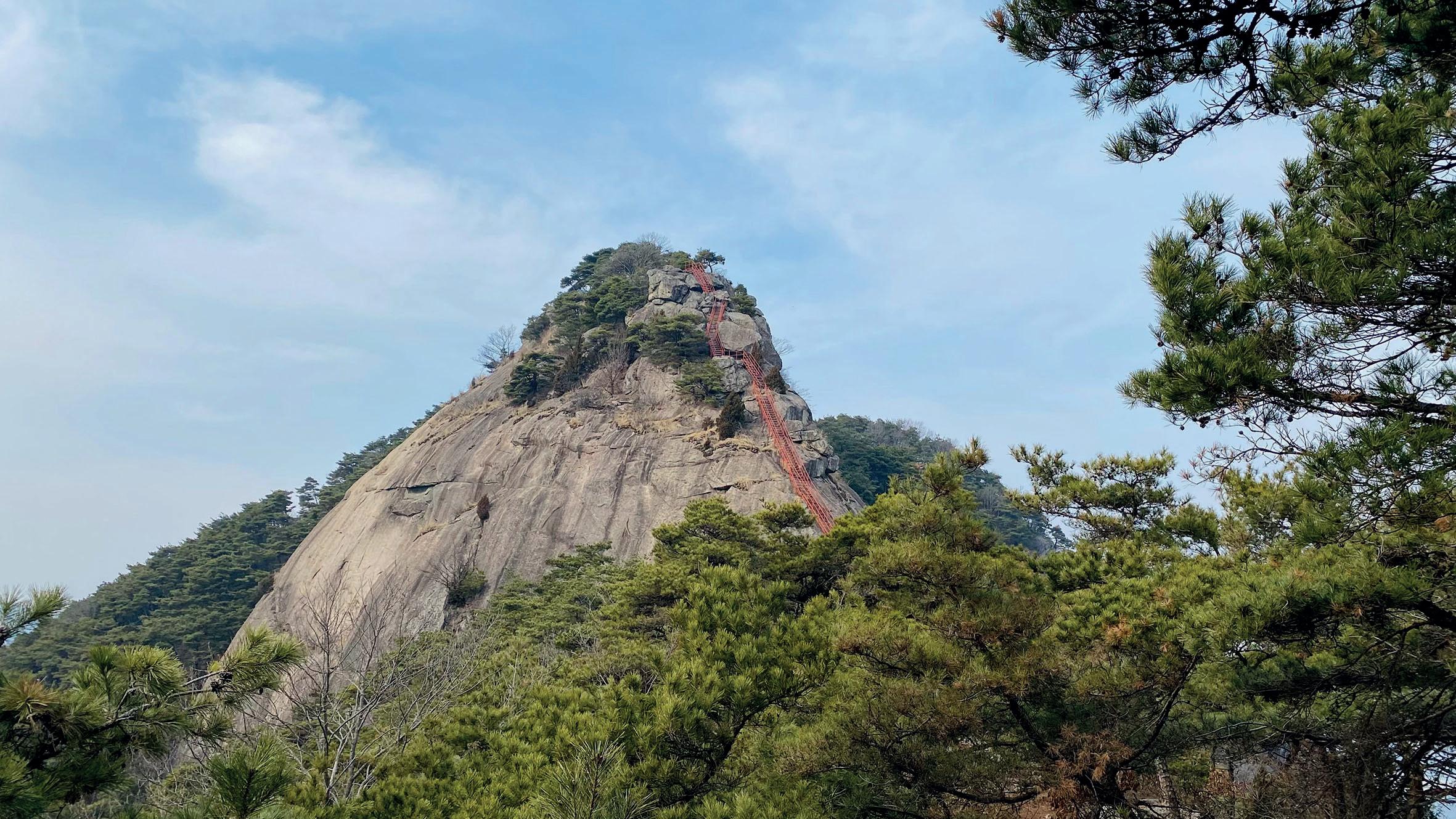
Hailing from Chino, California, Isaiah Winters is a pixel-stained wretch who loves writing about Gwangju and Honam, warts and all. He’s grateful to have had the opportunity to write for the Gwangju News all these years. More of his unique finds can be seen on Instagram @d.p.r.kwangju and YouTube at Lost in Honam.

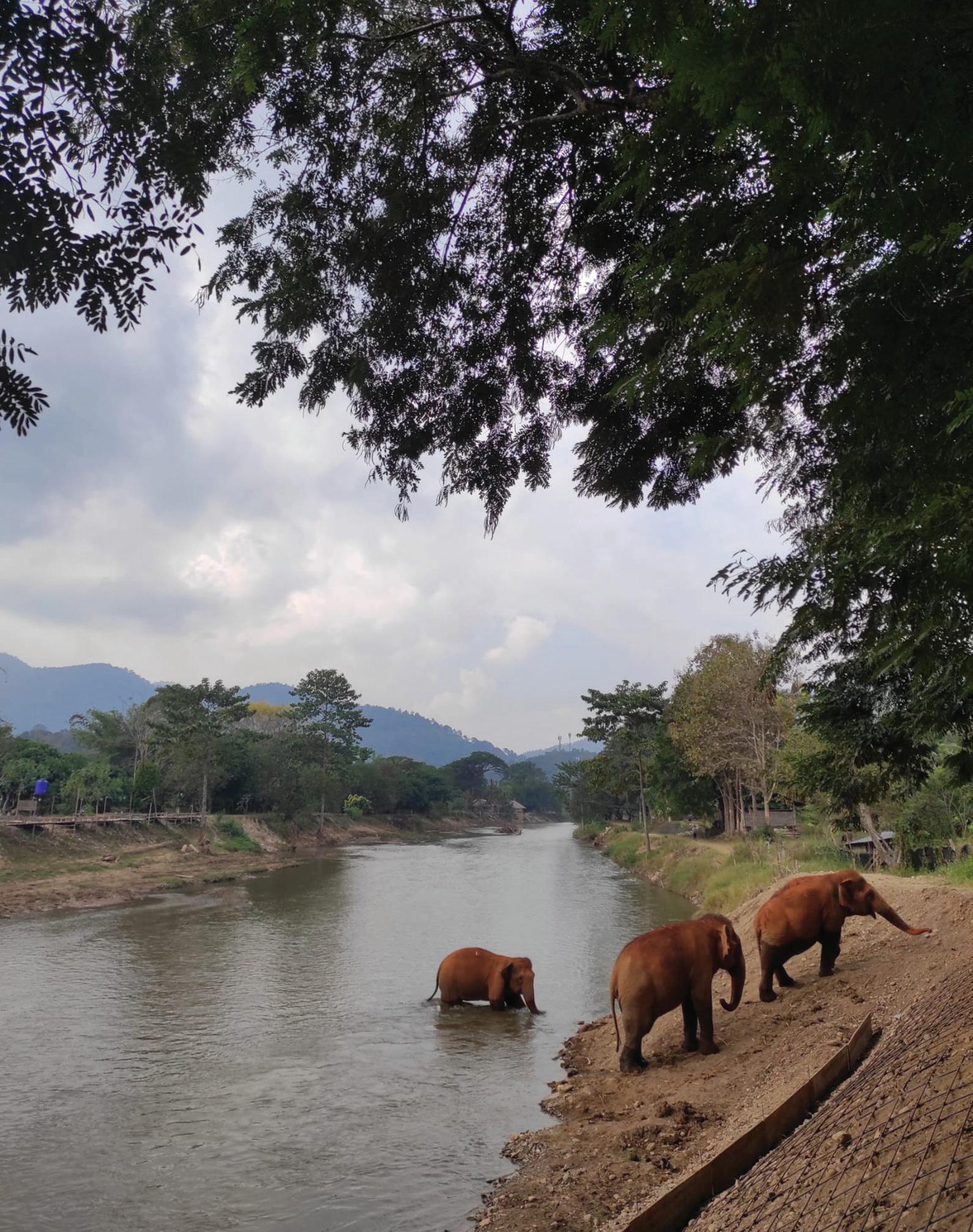 By Nicola Archer
By Nicola Archer
The world’s largest land animal, elephants, are highly intelligent and sensitive with an incredible memory. We have all heard of the idiom “an elephant never forgets,” right? Well, it is completely true – they will always remember a face!
A good memory and high levels of intelligence are what elephants are admired for in Asian culture, and in Korea, elephants symbolize wisdom and longevity. They are considered to bring good luck and prosperity. But why is it that elephants are the victims of so much suffering?
In the wild, elephants are at risk from having their natural habitat destroyed and being hunted for their tusks and trunks. It is not only elephants in the wild that are in danger, as elephants in captivity are suffering, too. They get their spirit crushed. They are beaten. Abused.
Young elephant calves get separated from their mothers, and both victims are chained and isolated, deprived of water and food until they succumb. This horrifying traumatic training method, called the “crush,” includes using sharp, pointed hooks to force
the animals to do what is unnatural to them. They live out their entire lives in fear, utterly helpless. What can we do to help them?
With travel restrictions being lifted, more people than ever are opting to travel, and the opportunity to see an elephant in Southeast Asia is high on many bucket lists. But can this be done without contributing to the cruelty? This last winter break, I went to Thailand to find out.
The elephant tourism industry in Thailand is huge. According to a 2020 report by the World Animal Protection organization, before the pandemic, this industry generated between 581–770 million dollars each year. That is a lot of revenue from a tourist attraction. Stalls line up to sell you their excursions: riding, bathing, and watching an elephant painting. But all of these activities are tremendously unethical no matter how “green” they might appear on the poster. Do not be fooled. Riding elephants causes detrimental spinal damage. Bathing with elephants causes them incredible stress, and they excrete in the water, so having them stand or sit around all day there so that visitors can take selfies is especially uncomfortable and unhygienic for them. And painting… seriously?! When did you ever hear of an elephant Picasso wandering in the wild?
Luckily, there are places out there that do support and nurture elephants who have previously suffered from abuse. Elephant Nature Park in Chiang Mai Province, Northern Thailand, is one. They care for distressed elephants from all over Thailand and place an emphasis on educating and encouraging visitors to observe the animals behaving naturally rather than forcing human-elephant contact.
Opportunities to visit and volunteer are available through their website, and booking in advance is highly recommended. Traveling on the hop, options to stay overnight at the rehabilitation center over Christmas were fully booked, so I opted for a day trip. Forget Rudolph and mince pies, it was going to be all about elephants and pad thais this last Christmas.
You think a traditional English Christmas dinner with all the trimmings is a lot to feast on? Elephants eat a lot! Although how much one eats can depend on its age, on average, an adult elephant could consume the equivalent of about two cobs of corn per minute!
foot-long spoon to scoop up solids with, I do not know!
Halfway through the day, you get to crave your hunger pangs, too, and are provided with a delicious vegetarian buffet lunch. Self-serve, you can take your lunch and find a spot on the viewing platform where you can delight at watching elephants in the distance going about their day. It is really quite breathtaking observing them meander around and please themselves. We even caught a glimpse of a playful, young elephant chasing after another making trumpeting sounds!
If you want to find out more about Elephant Nature Park or make a booking, you can find them on Instagram, Facebook, Twitter, YouTube, and their website (details at the end of this article.)
There are many other centers in Thailand putting elephant welfare first, and the World Animal Protection charity website has a convenient list of elephant-friendly venues in Thailand, Cambodia, and Nepal. Be savvy. If you want to see an elephant on your travels, do your research. Do not let posters use selective wording like “sanctuary” or “orphanage” fool you. Choice vocabulary like that does not necessarily equate to higher animal welfare. Be aware of the unethical practices that still exist and know you have a choice to make a stand for what is right and not support those companies that endorse abuse. Help elephants live the peaceful, playful life they deserve.

Helpful Websites:
• Elephant Nature Park
(https://www.elephantnaturepark.org/)
• World Animal Protection
(https://www.worldanimalprotection.org/elephantfriendly-tourist-guide)
• People for the Ethical Treatment of Animals (PETA)
As a one-day visitor at Elephant Nature Park, you will get a tour of the park, which includes a backstage look at the kitchen – storing stacks of bananas and watermelons. Fruits are one of their favorite things to graze on. While we were there, we were lucky enough to catch snack time and observe some being fed by the center’s local employees. It was so impressive how the animals maneuver their trunks to eat with. I struggle picking up noodles with two chopsticks, so how I would cope with one seven-
(https://www.peta.org/action/can-help-stop-elephantabuse/)
The Author
Nicola Archer is a Kia Tigers’ enthusiast and an animal rights campaigner. While living in Gwangju, she enjoyed being a part of the Gwangju Hikers club and the occasional saunter down Chungjang-ro.
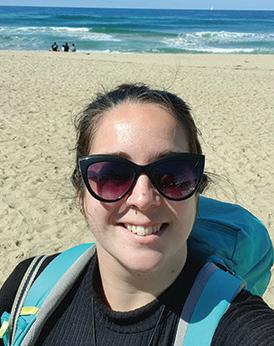

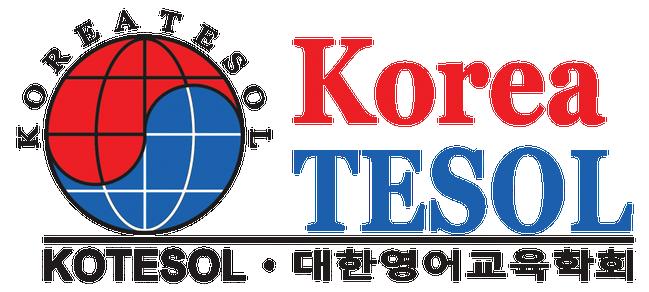 By David Shaffer
By David Shaffer
Google’s Bard, Amazon’s Lex, Microsoft’s Bot Framework, and of course, OpenAI’s ChatGPT – these are all chatbot platforms that possess natural language processing capabilities. They are not to be confused with personal assistants such as Apple’s Siri and Amazon’s Alexa. Though all use artificial intelligence (AI), personal assistants are programmed to directly control digital devices and applications to make daily life more convenient for the user.
Chatbots recently shot into the popular dialogue, propelled mainly by the release of ChatGPT a few months ago. It has been lauded is some circles as a godsend, while others denounce it as bedeviling, especially those in the field of education. Here we will discuss what ChatGPT can do, what it does well and not so well, and the impacts that it might have in the fields of education and second language learning for both teachers and students. (By the way, the “GPT” in “ChatGPT” stands for “generative pretrained transformer,” a technology that analyzes input text and predicts the output by training itself on a large dataset to produce human-like written language.)


The fields of design, manufacturing, and marketing have already espoused AI to optimize products, adjust design, target advertising, and improve customer service. Using the same technology that powers ChatGPT, CarMax is summarizing its many customer reviews, and the groceries delivery and
pick-up company Instacart is integrating ChatGPT into its customer service to respond to customer questions.1 AI chatbots, of which ChatGPT is presently the most advanced chatbot resource available, apply natural language processing technology (as opposed to computer language) to large language models to create their database of knowledge to answer written questions and perform certain tasks such as writing essays and creating poetry. (You may remember that the mystery story in last month’s issue of the Gwangju News was written by ChatGPT.)
While there is the potential for AI to be used for nefarious purposes, it appears that ChatGPT does not provide information on how to accomplish activities that are illegal and unethical. In a recent New York Times article, Noam Chomsky states that humans can still outthink AI. He argues that ChatGPT and similar chatbots are inadequate for producing meaningful human language, as they simply mimic language usage rather than understanding its meaning.2 And if you ask ChatGPT if it agrees with Chomsky, it will say that it agrees completely!
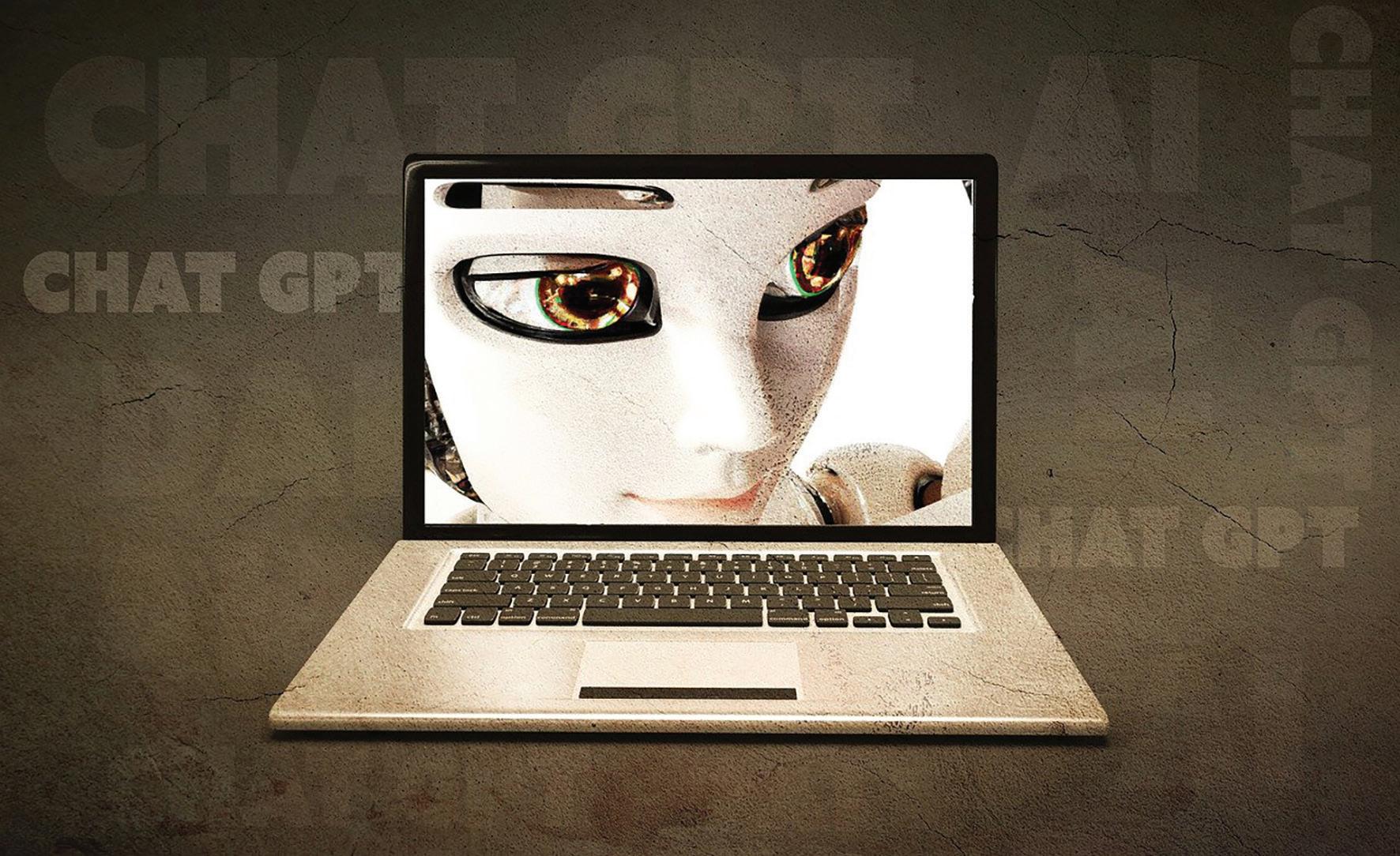
Svetlana Kandybovich echoes Chomsky’s sentiment: “GPT is powered by a large language model, which is ultimately a statistical tool which is asked to produce statistically plausible answers. It’s used to predict language without understanding” (37’ 03”).3 Kandybovich goes on to say, “So all it does is spit out what it expects is going to come next. This means that GPT may generate incorrect answers by unintentionally putting the wrong bits of information together. It never generates anything too unexpected, so it’s like the average of all the contents on the internet now. GPT cannot be trusted as it does not have any inbuilt notion of what is true and what is not” (37’ 23”). An anecdote to add here is that when I asked ChatGPT in Korean whether it knows Korean (한국말을 아십니까?), it replied that it knows Korean very, very well (네 한국말을 아주 잘 아십니다), using an honorific form in reference to itself, something that is not done in Korean. However, Kandybovich goes on to say that although ChatGPT was not designed for second language learning, it has potential for use in both language teaching and learning.
Let’s see what ChatGPT has to say about its potential for language learning. I asked ChatGPT to tell me in about 300 words how it can be beneficial in learning a second language. It told me that it is a potentially valuable tool in allowing users to interact with a virtual conversation partner in the language that they are learning to build conversational fluency. It can do this by answering the user’s questions – something that ChatGPT is quite good at. And it is always there for you for real-time interaction, while your dialogue partner on text messengers may not be. ChatGPT provides immediate feedback and error correction. If you ask it whether something is grammatically correct, it will often provide you with the correct form without even being asked to.
As ChatGPT is software rather than “humanware,” it removes the fear that so many learners in Korea have of making mistakes. This fosters the building of learner confidence and motivates further learning. ChatGPT can also help learners with understanding the nuances of the target language if the learner asks ChatGPT about items that they have encountered elsewhere, such as idioms (“He kicked the bucket”), culture-related elements (“Why do English speakers say ‘thank you’ so often?”), and things like jokes and sarcasm.
ChatGPT will repeatedly tell you that it can provide the language learner practice with “human-like conversation.” Let’s take a minute to consider this, though. Conversation is oral dialogue, but ChatGPT has no capability to produce oral output. Its output is written only. You could copy-and-paste the text it produces into a text-to-speech device as you can do the same with any digital text. This still does not make its written output highly conversational because its output is in a more-formal written style than in spoken style. Spoken language also contains pauses ( . . . ), fillers (ah, um, you know), false starts, intonation, accents, gestures, and a wide range of contractions (she’ll, gonna, y’know) that
ChatGPT does not produce. Additionally, its replies to questions are stilted rather than conversational in that the question is often repeated in its entirety, albeit restructured, in the answers it produces. For example, if you ask ChatGPT “Does Texas border four states, one country, and five bodies of water?” it will reply “Yes, Texas borders four states, one country, and five bodies of water” rather than the idiomatic “Yes, it does.”
environment – yes, it has engaged me for hours with its written input/output interactivity. Immediate feedback – one does not need to wait their turn to speak as they would have to in a classroom with two dozen classmates. No fear factor – one does not have to worry with ChatGPT of 50 piercing human eyes staring at you as when you are taking your turn to speak in the classroom. Practice at your own pace –this is easy to do with ChatGPT but very difficult in a classroom of 20-plus students, even if the teacher uses differentiated learning techniques. The fear of being the last one to complete the activity is gone with ChatGPT.
In addition to ChatGPT not producing oral output in its interaction with its user, the user does not speak either. The user’s output in also written, so there is no oral speaking practice taking place. The chatbot–user interaction is more akin to sign language than it is to speaking practice. As you can see, although ChatGPT does have capabilities that can be helpful to a language learner in improving their conversational skills, its ability to produce “human-like conversation” is limited in multiple ways.
Ask ChatGPT what the advantages are of using it for second language learning over learning in the classroom, and it will tell you some advantages that are hard to argue with. An engaging and interactive
Does this mean that ChatGPT and similar chatbots will be replacing the classroom teacher? Don’t get too concerned just yet. Even ChatGPT can tell you that the human teacher can be of value in ways that ChatGPT cannot. A teacher can act as a mentor, giving direction and feedback focusing more directly on a student’s needs. A teacher can provide personalized guidance in language learning skills (e.g., pronunciation for speaking, phonics for reading, and grammar correction). A teacher can provide a more holistic approach to language learning, incorporating the four macroskills into a single activity, as well as incorporating microskills and even cultural and custom aspects associated with the language. A teacher can also provide an array of interesting and interactive activities to engage students, as well as a multitude of multimedia materials: videos, audio materials, songs, PowerPoint presentations, language learning apps, etc. And very importantly, a teacher can provide a model of oral speech and idiomatic conversation, and also very importantly, the teacher can have students interact with their peers in practicing their oral skills.
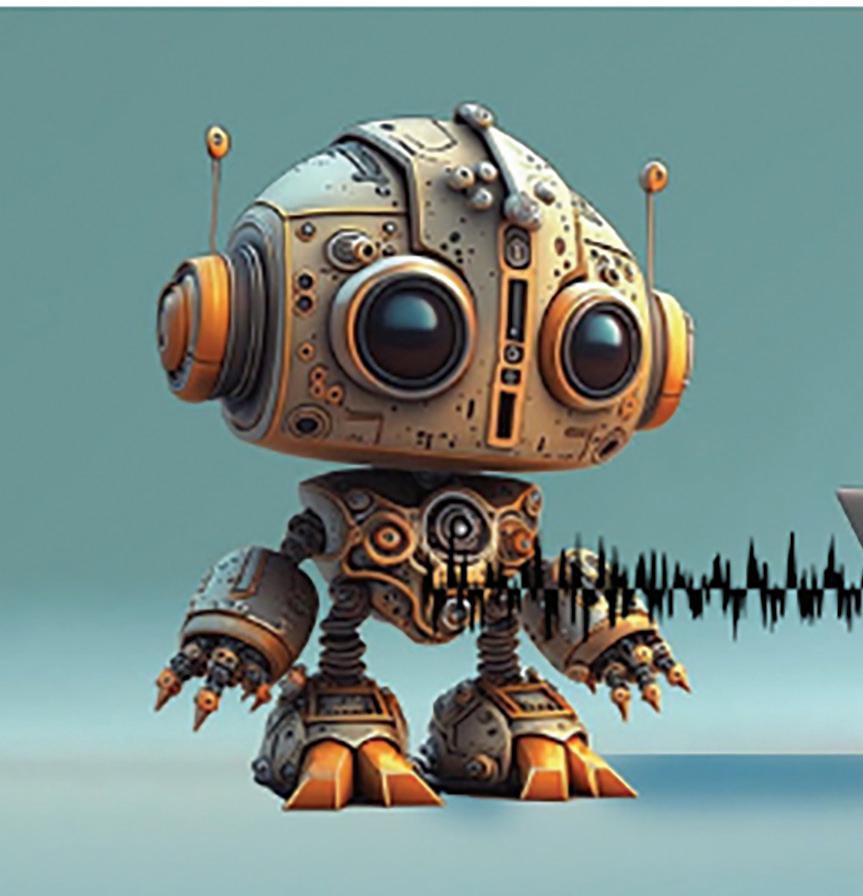
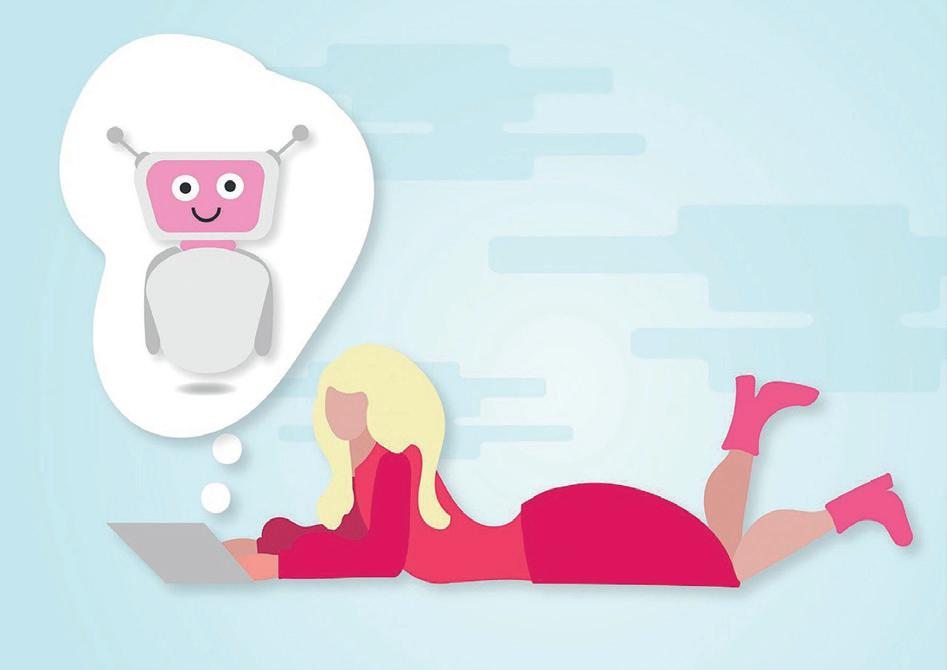
Presented above are strong points of both ChatGPT and the
“As ChatGPT is software rather than “humanware,” it removes the fear that so many learners in Korea have of making mistakes.”
classroom teacher. Rather than trying to choose which may be better, the two can and should complement each other. While the teacher is well suited for the classroom environment, ChatGPT can be an excellent supplement for out-of-class language learning. The teacher can assign activities for students to do with ChatGPT as homework. Especially useful would be activities that foster a sense of language learning autonomy in students. Once students realize how to use ChatGPT and the variety of language learning activities that they can do efficiently and interestingly with ChatGPT, they will be on their way to much more autonomous language learning.
Much of the uproar that occurred when ChatGPT came out, among educators in general and among language educators specifically, was that ChatGPT and similar chatbots can be used to do homework assignments. This chatbots can do well for a variety of assignments. However, in checking this out for essay writing, I asked ChatGPT to produce an essay of about 500 words using the five-paragraph model. What I got back, to my surprise, was a 250word composition of three short paragraphs. Not a passing grade in my book, though the grammar was perfect.
What teachers need to do is familiarize themselves with chatbots, i.e., with what they can do and the type of output they produce. Then, give homework assignments that would be difficult for a chatbot to do well. Remember when the internet first came into widespread use? Everyone was so worried about copy-and-paste plagiarism. But various ways have been found to detect it, and it is not longer considered such a big issue. I imagine that something similar will occur involving academic integrity in relation to chatbots. As one educator put it, “To overcome these challenges, language instructors need a good understanding of the tool and must

closely monitor and supervise students’ learning experience with it.”4
As with most any good thing, it can also be put to a bad use. Teachers must, of course, be vigilant in guarding against such misuse. However, as ChatGPT can be such a powerful language learning tool, we should embrace it in our teaching, in our lesson preparation, and in our students’ learning.
O’Brien, M., & Hadero, H. (2023, March 8). From marketing to design, brands adopt AI tools despite risk. Chicago Tribune. Chomsky, N. (2023, March 3). Noam Chomsky and AI: Humans can still outthink machines. The New York Times. Thornbury, S. (2023, February 18). OpenAI and the future of language teaching [Webinar]. YouTube. https://www.youtube. com/watch?v=zS0cd7e_hh4
Cai, W. (2023, February 24). ChatGPT can be powerful tool for language learning. University Affairs. https://www. universityaffairs.ca/career-advice/career-advice-article/ chatgpt-can-be-powerful-tool-for-language-learning/
David Shaffer has been involved in TEFL, teacher training, writing, and research in Gwangju for many years, almost totally as a professor at Chosun University. As vicepresident of the Gwangju-Jeonnam Chapter of KOTESOL, he invites you to participate in the chapter’s teacher development workshops and events (online and in person) and in KOTESOL activities in general. Dr. Shaffer is a past president of KOTESOL and is the editor-in-chief of the Gwangju News.
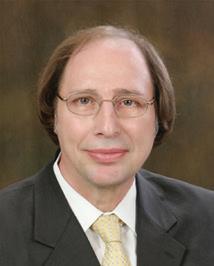
Gwangju-Jeonnam Chapter Workshop
• Workshop Topic: What Does Artificial Intelligence Mean for Language Teachers?
• SwapShop Topic: Top Tech Tips, According to Real Teachers
• Venue: Gwangju National University of Education
Check the Chapter’s webpages and Facebook group periodically for updates on chapter events and other online and in-person KOTESOL activities.
For full event details:
• Website: http://koreatesol.org/gwangju
• Facebook: Gwangju-Jeonnam KOTESOL
It is very important to define the terms practical and life to understand the whole concept of Practical Life Education. The word practical means something that we can apply to our everyday living. It is realistic, active, sensible, and pragmatic. The word life is the condition that distinguishes animals and plants from inorganic matter. Practical Life activities are applied in the classroom so the students can learn how to perform living activities in a purposeful way. The main purpose of Practical Life Education in the Montessori classroom environment is to assist the children to control their body movement, teach them how to focus on their work, and help them to be more independent. Through all of these processes, students can build their own life skills and positive habits for their long journey.
There are four big, main categories in Practical Life Education. The first category is Movement Education, which can be further specified as Control of Gross Motor and Fine Motor Movements. Maria Montessori particularly emphasized Movement Education because she believed that it assists and accelerates the child’s motor and physical development. She stated in her 1973 book The Discovery of the Child, “One of the most important practical aspects of our method has been to make the training of the muscles enter into the very life of the children so that it is intimately connected with their daily activities. Education in movement is thus fully incorporated into the education of the child’s personality” (p. 79). Based on her statement, we can understand how much she valued Movement Education. Inside and outside of the classroom, through countless repetitions, from small movements to large movements, children develop
muscles in various parts of the body and learn how to use them correctly. And the more their muscles develop, the more children work harder and, as a result, gain more experiences.
The next category is the Care of Self. The main point of this section is the development of a sense of independence and self-sufficiency. By learning this area, children have a lot of time to think for themselves. They are able to think about what they

need and what to do, and through those countless thought processes, they restore their confidence and realize their importance. Also, this section is related to hygiene education. They will learn how to clean themselves, and this concept will spread out to the many different branches of personal hygiene that will become important when they get older.
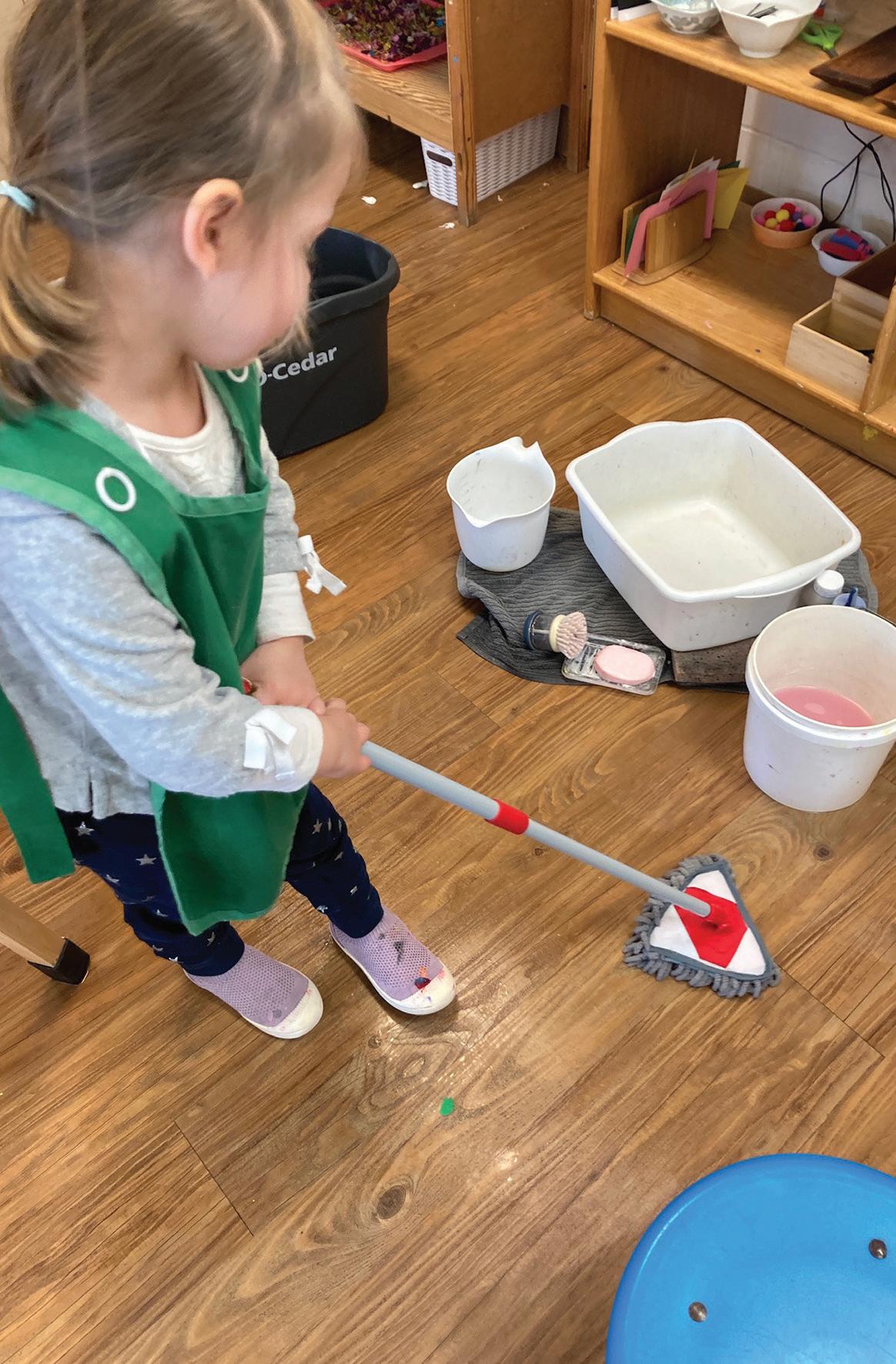

All these concepts naturally lead to the Relationship portion, which is the last category of Practical Life Education. All relationships are built on a wellprepared “self.” The word prepared here means that when I can manage and control myself, and when I can organize my environment and manage it including others, all while keeping self-reflection in mind, the right relationship is formed.
Reference
At the same time, they will practice Care of Environment, which is the third category. Organizing the environment around you is like homework that a person should always do in life. Others use the things that I use, and we always share the space together. This is always happening anytime, anywhere. We never monopolize anything alone. That is why we must always be able to properly manage the environment we share.
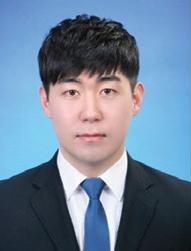
“And the more their muscles develop, the more children work harder and, as a result, gain more experiences.”▲ Sewing ▲ Mopping Montessori, M. (1973). The discovery of the child. Ballantine Books.
지수: 민지가 이번 교사 자격증 시험에 합격했대. Jisoo: Minji recently passed the teacher certification exam.
정민: 그래요? 오래전부터 준비해 왔는데 드디어 합격해서 다행이네요.
Jeongmin: Really? She has been preparing for it for a long time, and I am glad that she finally passed it.
지수: 맞아. 나도 준비할 걸. Jisoo: Right. I should have prepared for it, too.
정민: 번역가 자격증 시험 합격했잖아요. Jeongmin: But you passed the translator certification exam.
지수: 그래도 교사 자격증이 땄으면 더 좋았을 텐데. Jisoo: Still, it would have been better if I got a teacher’s license.
정민: 남의 떡이 커 보이는 거야. 번역가 시험도 대단한 거예요. Jeongmin: The grass is always greener on the other side. The translator license is also a great achievement.
지수: 하하 그래? 정민 아주 긍정적인 사람이어서 좋아. Jisoo: Ha-ha you think so? It is good that you are such a positive person.
교사: teacher, 자격증: license, 시험: exam, 합격하다: to pass, 준비하다: to prepare, 드디어: finally, 번역가: translator, 자격증을 따다: to pass a qualifying exam; to receive a license, 대단하다: to be great, 긍정적이다: to be positive
V~을/ㄹ 걸: This grammar point is used with verbs and acts as an ending that expresses a feeling of regret on the part of the speaker. It is like English’s “should have done (something).” Use “~ 을 걸” when a verb ends in a final consonant (받침, batchim), and “~ㄹ 걸” when it ends in a vowel.
Ex:
- 더 열심히 공부했을 걸 I should have studied harder.
- 비가 오지도 않았는데 우산을 사지 않았을 걸. It did not even rain; I should not have bought the umbrella.
남의 떡이 더 커 보인다: This frequently used proverb is exactly the same as English’s “The grass is always greener on other side.” The use of “떡” (tteok) in the expression reflects the significance of rice cake in Korean culture.
Ex:
가: 미국은 한국보다 살기 좋아요.
It is more comfortable to live in the USA than in Korea.
나: 남의 떡이 더 커 보여요. 미국에서 먹고 사는 게 너무
힘들어요
The grass is greener on the other side. It is as difficult to make a livelihood in the USA.

The Author
Harsh Kumar Mishra is a linguist and Korean language educator. He volunteers with TOPIKGUIDE.com and Learnkorean.in. He has also coauthored the book Korean Language for Indian Learners.

Wheeling the bike onto the Mugunghwa carriage, I lock it to a pole and take a seat. I want to watch the beautiful Korean countryside slide by. The train jolts to a start and the city soon slides into open, lush, green countryside. I relax and am happy – for a brief while – at the thought of returning to the even more beautiful southwest corner of the peninsula.
But as the train glides south, a frightful vision rises out of rice fields. Like a scary movie monster threatening an attractive film star, all over the previously pristine Korean countryside is a rapidly rising slew of milking factories and dairy cow sheds. Now, these days, I am fearful about the state of the drought emergency in Jeollanam-do, but since that train ride just two years ago, the development of this drought has not been surprising at all, and this is why: I have already seen this awful environmental own-goal happen before elsewhere, twice.
The meager good news is that there are a couple of easy and very affordable things we can all do today –and every day – to make an immediate, meaningful, and lasting difference in a shared effort to avoid more such awful situations as this dry spell.
How stressful was it/has it been for you? What did you do, or have you done to help reduce the impact of water scarcity on yourself and others? How are you helping to share the effort of preserving what little is left and avoid future droughts? Was your apartment’s water pressure reduced, or have you put a brick or something else bulky in your toilet’s water cistern?
These are valid, creative ideas for reducing individual
impact on a small scale, and Chung Hyunhwa was right to offer them as ideas here in the Environment column within the Gwangju News (issue #251). Our good editor, William Urbanski, also offered useful personal reflection on real lived experience and the perils of industrial-strength overcrowding via carbon-intensive concrete jungle apartment blocks on the local water table and our collective psyche alike (also issue #251).

We are, however, missing an important part of the story of water demand, depletion, and degradation, as it affects this and future water shortages. The film Cowspiracy: The Sustainability Secret was released and added to the documentaries available on Netflix in 2014. One of the best things about this film is its use of infographics clearly explaining the environmental damage created by industrial animal agriculture.
One of the most disturbing sections of the movie focuses on the use and abuse of water by beef and dairy farms. Filmed in California before 2013, it precedes the current state of ongoing severe drought
▲ We do not often think about the amount of water needed for different daily activities. (cowspiracy.com/facts)


throughout the central and western USA. But already a wide range of other major environmental issues had been resulting directly from beef and dairy farms, including local health impacts on humans, and oceanic “dead zones,” vast offshore areas where farm pollution is so thick that all other life forms die.
The year Cowspiracy was released, Oxford University scholar Professor Joseph Poore started a new study. Like all good scientists, he and his research team were skeptical and set out to disprove the film. In 2018, news of their five-year-long study was published in the prestigious peer-reviewed journal Science. Reputable paper The Guardian reported their study with the headline “Avoiding meat and dairy is ‘single biggest way’ to reduce your impact on Earth.” Two of the areas studied were freshwater use and water pollution.
Since the day I first watched Cowspiracy, I had been waiting for someone to make a similar film on the mess dairy farms are making of the land and waterways where I was born: Aotearoa (New Zealand). The severe situations in the two countries are remarkably similar in many ways, including the awful impacts of dairy farm pollution on freshwater supplies.
The documentary Milked was released in 2021. While focusing on the impacts of the dirty dairy industry, it takes a balanced, nuanced, even supportive approach to New Zealand’s dairy farmers. Freshwater ecologist Professor Michael Joy speaks about how most native species of fish and other indigenous wildlife are now endangered and threatened with extinction as
a direct result of all the poohs and wees from too many cows on too many fields on too many dairy farms all around the main islands of the country; however, he takes a positive approach to farmers. Dr. Joy suggests the government support dairy farmers with financial subsidies to help them transition out of animal agriculture as soon as possible.
I have a similar sense of sympathy for folks who are still quite literally addicted to the taste of cheese: Milk contains casomorphins, much like morphine, and makes us physically want to eat more. A cow’s calf is larger, grows more quickly, and is much more mobile than a human baby, so its mother’s milk has a larger, stronger dose of casomorphins to make the calf want to stay close to the safety of her side. When we take that milk and concentrate it into cheese, it intensifies the high that makes us want to return to the same cheese box in our fridge or pizza restaurant nearby.
But it is very possible to choose to change – and to stay changed – in our daily eating habits, as most of us know from our own experiences of changing our daily diet decisions, whether out of choice or availability. Local Koreans may have enjoyed foods from other cultures sometimes. Those of us who were born elsewhere and now live in Jeolla-do perhaps eat differently to when we were growing up, maybe including more spicy and salty foods for breakfast.
Long before I moved to Gwangju, I chose to stop eating meat and animal fat-based cheese, but perhaps up to about six months after I made that decision, I very occasionally still craved only pepperoni pizzas
from a favorite downtown cafe. Those feelings soon faded, and my taste and health improved. Also, now, proven nutritional science to support what we already know about how we can consciously choose to change our taste buds has emerged.
Medical researcher Dr. Will Bulsiewicz is a USA board-certified gastroenterologist and author who highlights the influence of the microbiome, or stomach bacteria, to affect not only how we feel, but how we think about what foods we want to eat next. Simply put, the more we eat of any food, the more bacteria we create to deal with it, and the more those bacteria demand even more of that food: The more sloppy, slimy pizza we eat, the more we will want it; or the more avocado salads we eat, the more we will crave that crisp, crunchy, fresh lettuce and rich, oily avocado instead.

But what else makes us continue to desire the animal fat-based foods that create so much damage to our waistlines and our home? In a single word: advertising. It is not only from the ongoing influence of family, friends, and colleagues that we give ourselves permission to continue in an unhealthy habit. We also get a face-full of reinforcement from media marketing all around us every day: photos of fatty, cooked meat in subway stations and bus stops; radio ads suggesting slurping more milk or scoffing more cheese; magazines and newspapers promoting meat-and-cheese-based restaurants; cafes where the only green tea option is a cow’s milk-based latte! Once we notice all the advertising
and narrow range of options focused on animal fat-based foods all around us, it really is difficult to avoid the feeling that an idea is being shoved down our throats, invading our senses of imagination and identity alike.
Why do we do this to ourselves and others? Why do we permit our national broadcasting standards agencies to accept advertising of animal fat-based foods despite their impact on lives in and outside farms, including our own? Cancer is out-ofcontrol cell growth often caused by the cow’s milkbased hormone IGF1; diabetes, obesity, erectile dysfunction, stroke, dementia, and other diseases are all similar blockages from eating too much saturated fat and the cholesterol only found in animal fat-based foods.
Last year, the Dutch city of Haarlem chose to end the advertising of meat products in bus shelters and on screens in public places. Adverts promoting consumption of animal milk-based “foods” will still be possible when the ban comes into effect in 2024, and meat will still be able to be advertised in newspapers and other public media.
This leaves room for Gwangju to be the first city to create a ban fully aligned with science, logic, and the danger of more drought: Gwangju could see an end to advertising for animal fat-based products including both dairy and meat, in public spaces and locally produced media.
This will happen when we do two simple things to help reduce the impacts of droughts: end eating and drinking all animal fat-based foods; and, much more importantly, simply talk. Insist on serious conversations with family, friends, colleagues, and especially local leaders at all levels: Demand to discuss the value of ending the advertising of animal fat-based foods.
▲ The award-winning documentary Milked (2021) from New Zealand exposes the high costs of the damage to NZ waterways as caused by the dairy industry and paid for by the NZ environment and all Kiwis. ( https://www.greenpeace.org/aotearoa/story/milked-documentaryreview-nov-2021/)
Julian Warmington taught for twenty years at the university level in South Korea, half of which he spent in Gwangju. He established and ran the Busan Climate Action Film Festival and has given presentations internationally on teaching environmental issues within ESL lessons and curricula. His favorite Korean foods include vegan hotteok, vegan patbingsu, and vegan dolsot bibimbap.

 By William Urbanski
By William Urbanski
My home country of Canada is a land of homeowners. Up in the Great White North, no figure of speech, no axiom is more ingrained into the collective consciousness than the old adage: “Paying rent is just throwing money away.” What this platitude implies is that in order to financially get ahead in life, a person must buy a house as soon as possible with no ifs, ands, buts, or maybes. This is why there is no shortage of twenty-three-year-old, unmarried, pimple-faced kids running around in a frenzy doing whatever it takes to borrow the hundreds of thousands of bucks necessary to buy a property.
Thankfully, the situation in Gwangju is much different. Sure, people love to buy houses, but this is usually reserved for later stages in life, and the decision to mortgage one’s life away usually coincides with other major life events like starting a family.
That being said, if you have spoken to one of the many, many homeowners in Gwangju lately, you have no doubt heard about how property prices, especially in certain districts, have been falling faster than the water level in Juam Reservoir. Plummeting prices accompanied by the twin boogeymen of inflation and high interest rates have many people wondering if buying a house (read: “apartment”) in Gwangju is still a solid investment.
Spoiler alert: It is not. A house that is a person’s longterm, primary residence is never a good financial investment and never has been. To boot, shifting housing preferences and the demographic realities in Gwangju might make it harder than you think to sell when the time comes.
Around Dongmyeong-dong and Gyerim-dong in southeastern Gwangju, some of the apartment prices have dropped dramatically. A reliable source told me that units in one particular apartment complex are listing in the fourhundred-million-won range when they were selling for over six hundred million won a year ago. Without getting into the complex economic reasons for this drop, it is plausible that people are getting tired of shelling out the big bucks to live on the twenty-fifth floor of yet another cookie-cutter apartment building that may or may not be of dubious construction quality. Sure,
Gwangju’s wildly fluctuating house prices beg the question if buying a home in the city is a solid investment or just throwing good money after bad.
the views from up there are probably nice enough, but the reality of living so high means it takes quite a while to get to the ground floor, if you, you know, ever have to leave your home or anything like that. To boot, you will not even have your own parking spot and will have to push double-parked cars out of your way before liberating your own vehicle from its parking space. But I digress .

According to the City of Gwangju website (which you should really check out if you have not already), nearly 35 percent of all households in Gwangju are single-family (and therefore single-income) households. This poses a significant problem for the Gwangju housing market because most high-rise apartment units are not designed for individuals and are actually completely impractical for a single person. Even if a single person had the means to buy a 34-pyeong apartment (and that is saying something), there are many other more attractive places to live that would require less maintenance and might even offer a parking spot so you would not have to push double-parked cars out of your way at 6:00 a.m. in the morning in the middle of winter so that you can leave for work.
Listen, I am not going to drone on and on about how
owning a house is all bad because, of course, there are some advantages. It offers stability as well as the right to modify as you see fit. Sometimes even the location is better than you could get otherwise. But there are two major reasons why your house is not an investment. First, you have to live somewhere, and unless you plan on downsizing, you are not going to get ahead financially by selling your house. Next, people tend to conveniently forget that while they are “building equity” by paying down their mortgage, they are actually getting completely shaken down by interest payments. Think renting is throwing your money away? If a person has a (modest) two-hundred-million-won loan at 5 percent (a dream rate nowadays), that is ten grand per year that is going to magically evaporate.
Gwangju has so many interesting districts with a plethora of housing options. While housing prices are relatively high, rents are surprisingly low. So low, in fact, that I would suggest that it actually makes more financial sense to rent instead of buy. In Gwangju, renting is not throwing your money away. It is more like the deal of the century.
There are good reasons to buy a house in Gwangju. Do it because you like Gwangju and want a place here to call your own. Do it because you do not want to come home one afternoon to find your landlord slinking around your home after you explicitly told him to call you before entering. Do it because you want to paint the walls whatever color you please. Heck, even do it because you want to feel the pride of ownership. But do not do it because you think buying a house is a guaranteed investment that will pave the way to financial success.
The decision to rent or buy is never as cut and dry as it seems. While “paying rent is just throwing your money away” is taken as gospel over in Canada, there is another expression worth considering: “Stop paying rent on your house, and you will find out who really owns it.”
William Urbanski is from Canada, married, and can use chopsticks. He does not spell his middle name with a hyphen. Instagram: @ will_il_gatto
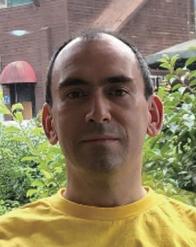
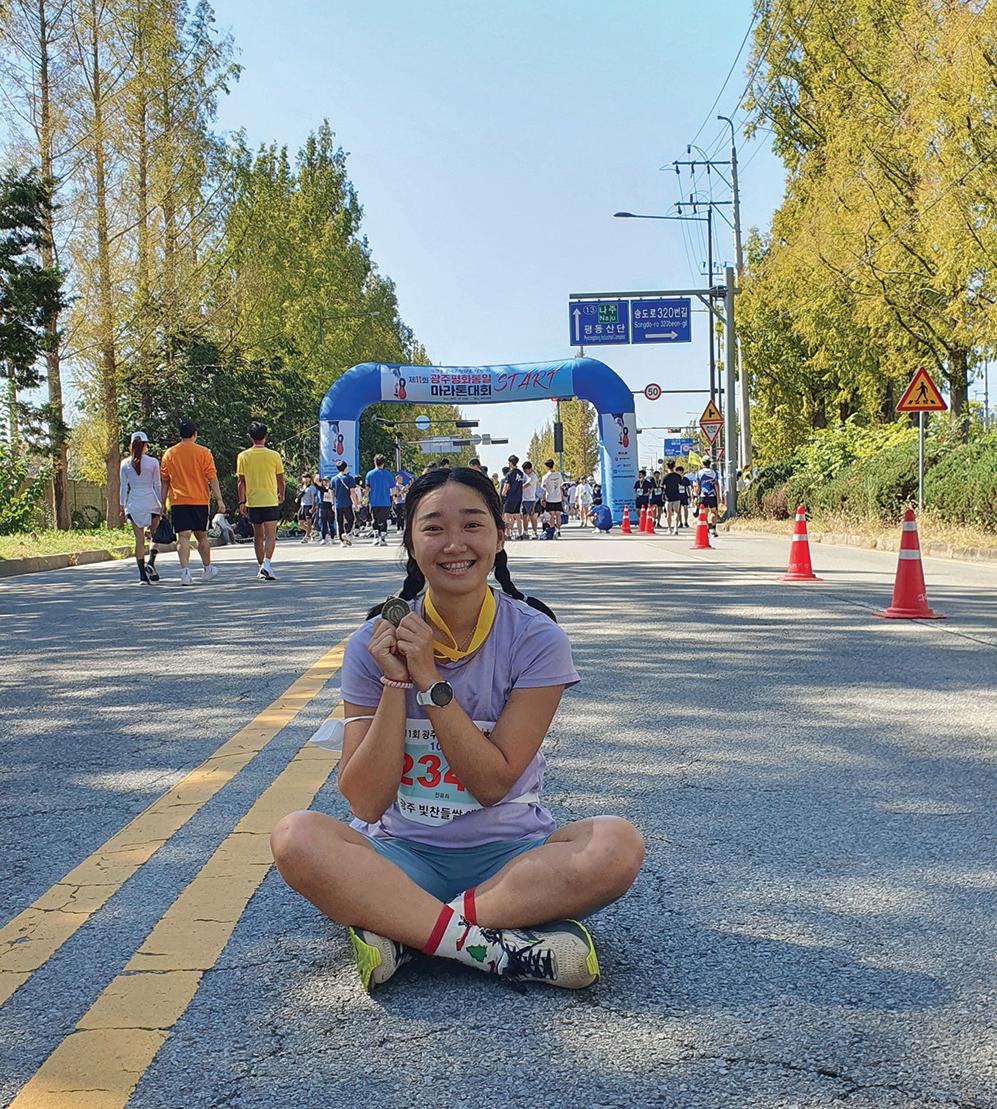
 By Grace Chun
By Grace Chun
The idea of voluntarily lacing up running shoes and heading out the door would have never crossed my mind two years ago. But a lot can change in two years. In those two years, I moved to Hawaii to start a graduate program, paused my studies to prioritize my mental health, and moved to Gwangju for the first time. In the midst of all these changes, I discovered running.
Still in the midst of a pandemic at the start of 2022, I ended up doing a lot of running on my own around my countryside neighborhood, jogging through every nook and cranny. My style of running is slow and steady, trying to maintain a pace where you can hold a conversation. My cousin introduced me to the app Somoim (소모임), where people can create clubs or groups locally. She encouraged me to look for a running club to join in Gwangju.
I came across a group called Running Running (러닝러닝) in Suwan (수완) that ran every Tuesday and

Thursday night. With hopeful anticipation, I arrived early. Slowly the club members started arriving and welcomed me warmly. They all ran at varying paces, but we started and finished together. The leader invited me to consider running in the upcoming 11th Gwangju Peace and Unification Marathon (제 11회 광주평화통일마라톤대회), announcing that they all signed up for the 10-km race. I signed up that night.
While moving to Gwangju was the right decision for me at the time, it was also a great loss of community that I had built in graduate school. I only knew my family here. Finding a group of people to run with helped me start building a community here in Gwangju. The running group became a positive feedback loop for my running motivations. I consistently showed up, and they showed up for me.
While we run at different paces, we cheer each other on when we pass each other on our weekly running course. As my first 10km race, my goal was to run at a steady pace for the whole course. Others had more ambitious goals of finishing within or under an hour.
My race packet arrived one week before the October 3 race. It included my bib number, an information booklet, and a few other goodies. I got a kick out of looking up my and my group members’ names in the booklet. They printed out the names of all the participants! I appreciated that I could study the route and also know where to park, get water, use the restroom, and more. I decided to wear shorts, T-shirt, hat, and sunglasses in anticipation of lots of sun. While October cools down in Gwangju, I did not want the sun to obliterate me.
The 11th Gwangju Peace and Unification Marathon’s course began at Gwangju Airport. On race day, instead of carpooling with my running group, I decided to take the subway, since I lived on the other side of town. One perk for race participants was that the subway ride was free! I did have an awkward encounter, however, with the subway employee asking if I was a minor. Nevertheless, I rode for free. As soon as I got off the subway and onto the street, a group asked me to take their picture. I happily obliged. They encouraged me with a “fighting!” (화이팅!) on my run and parted ways. I already felt the buzzing energy of the runners, and I loved it.
Once I met up with my running group, we left our things in the very efficient storage facility (보관소) run by volunteers. I do not mind running with a fanny pack, so I kept my things with me. The race booklet suggested arriving early, and I was glad we did because parking became a bit stressful as we approached the start time. The MC led a race-wide stretch session, which was a fun sight. I was surprised to see so many people of all ages present. The MC
announced that over 4,000 people were participating this year. Stretching all in the same motion gave me a joyful sense of unity and connection to the fellow runners in Gwangju that day.
While the race itself is called a marathon, participants can sign up to run 5-km, 10km, a half marathon, or a full marathon usually. The route this year was an outand-back course. I enjoyed the course because I could cheer on my fellow running group members as they passed me. As I expected, I was in the back of the pack. However, I achieved my goal of running at a steady pace the whole time. I probably could have run harder, but my goal was not a personal best time for this race. My goal was to run steady, and I did.
After crossing the finish line, I received my snack and medal. I was the last one to finish in our running group, and they kindly waited for me to finish. We headed our separate ways to freshen up before reconvening in Suwan for a celebratory lunch of all-you-can-eat Korean BBQ.
As a newcomer to Gwangju, one of my favorite experiences here has been joining the running group and participating in the 11th Gwangju Peace and Unification Marathon 2022. It was the first time I felt like I was really part of the Gwangju community doing something I have come to love.
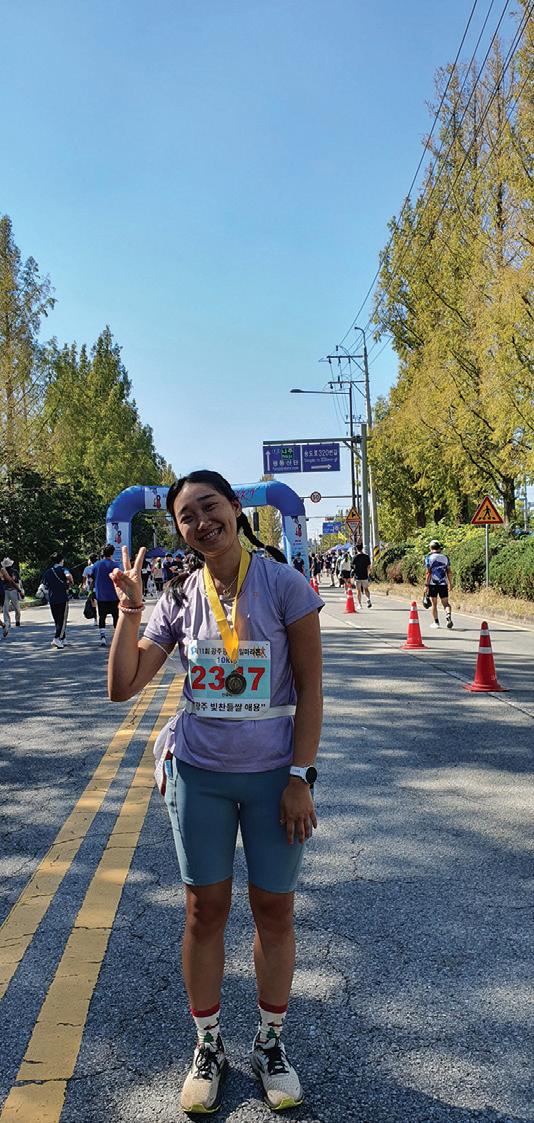
Gwangju is hosting the 2nd National Mudeungsan Mudeung-gil Road Competition (제2회 전국무등산무돌길완주대회) on May 20, 2023. You can register until April 1. For more information, check out their website: http://mudolgil518.or.kr/
The AuthorGrace Chun (Chun Yu-ri) has lived in Gwangju for a little over a year. She is a Korean American graduate student studying migration and borders. She enjoys farming with her dad, taking film photos, dabbling in coding, and running, of course.
Instagram: @gycphoto

We’ve all been raised on television to believe that one day we’d all be millionaires, and movie gods, and rock stars. But we won’t. And we’re slowly learning that fact. And we’re very, very pissed off.” – Tyler Durden quote from the film Fight Club
My desk was piled high with homework, and my final test was in two weeks. I’m a sophomore who still hasn’t visited much of the country; I’m disappointed that life isn’t full of new experiences after working hard in high school but rather more pressure in a higher institution. And I’ve diverted significantly from my initial intention of studying in another country to travel more and explore new things. Everything had to end, so I planned to make the most of my winter break by touring South Korea and finding new things in Gwangju, such as tasty cuisines and art galleries.
In this article, I’ll talk about some of the fun activities I did in Gwangju before I left to another city. Being a lover of horror and thriller films, I went to the 2022 ACC Context “Attention! Zombies” reinterpretation and visual examination of how zombies were created and how they’re depicted in various areas such as South Korea and the United States. The event was free to attend and took place in Asia Culture
Center (ACC) spaces 3 and 4 from October 20, 2022, to February 26, 2023. The entryway was slightly dimly lit and had a creepy atmosphere. It began with a chronology of how zombies, or these “Contemporary Monsters,” came to be in both South Korea and the United States. I discovered a detailed description about one of my favorite horror films, Warm Bodies, a zombie romance. There was a drawing space in one of the locations where you could sketch your interpretation of a zombie or what the viewers perceived zombies to look like. On a wall full of drawings ranging from informative to humorous, I too participated and sketched my idea of a zombie. There were also a lot of images, videos, and illustrations to look at. You might also attend extra free entrance programs along the way, which I did.
I’d heard a lot about how delicious the food in Gwangju is before I arrived here for the first time. I wanted to use this outing to taste a Korean food at one of the places called Matgol (맛골) that a friend suggested. This is a jeondae matjib (전대 맛집), which means a “Chonnam University must-eat place,” and is quite near the campus. Our dormitory was roughly a five-minute walk away. The restaurant had a motherly feel about it, and the inside was larger than I expected from the exterior. There’s a sitting table for cross-legged seating as well as a chair table. Because the table is quite spacious, various

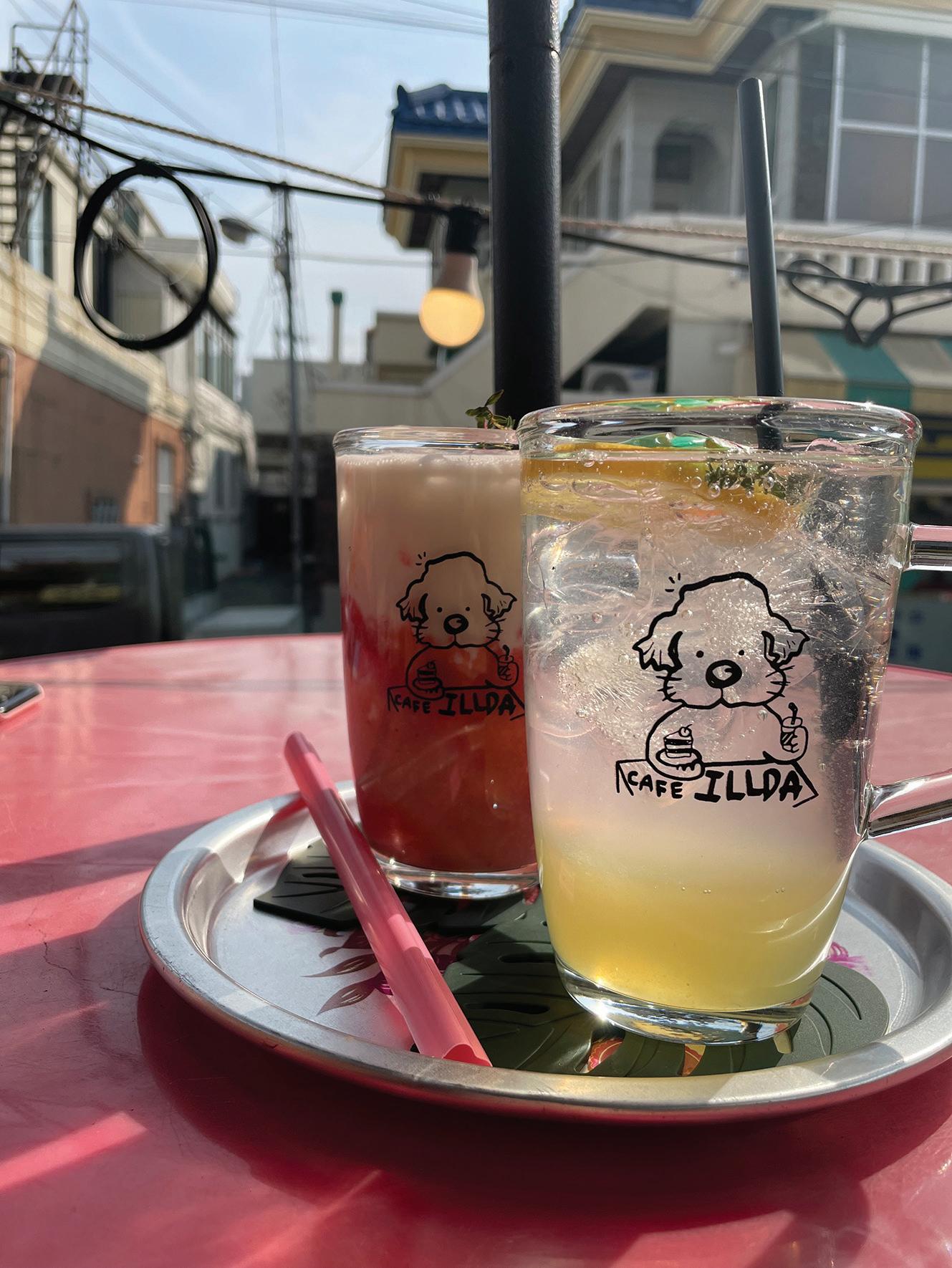
side dishes can be served. The high quality of the side dishes is one of Matgol’s most enticing features. A variety of side dishes are available. The majority of the food costs between 7,000 and 8,000 won. When it’s midday, the restaurant soon fills up, but the side dishes arrive before the main meal, so you can enjoy them while waiting. We ordered kimchi jjigae (김치찌개, kimchi stew) and aehobak jjigae (애호박찌개, zucchini stew) because it was a cold day and we wanted something warm. In general, it’s a fantastic place to visit if you’re missing stew.
Another wonderful spot to eat near Chonnam National University is Ilda, a dessert café. The well-decorated cafe, located at CNU’s back gate, has a lot to look at. The facility includes two floors, one with chairs for viewing the outdoor vista and another for sitting inside. The interior design incorporates vintage phones, photo posters, and picture frames. There were several mirrors in ancient frames across the room, varying in size from huge to little ones. The couch is particularly stunning and complements the overall aesthetic of the cafe. The structure of the building resembles a house that’s been turned into a café. I’d been to the café before, but this
time I saw that there’d been many changes to the seating arrangement and decor; while it still has the vintage décor feel, there’d been many additions. Anybody interested in visiting the café should keep in mind that they open at 12:00 p.m. and will be so crowded that you may not be able to secure a seat. This happened to me and a friend as well, but fortunately, another customer departed, and we took their seat.
The winter vacation was long, and I tried many things, but I wanted to share some of them with you so that you may check out other programs at the ACC or other locations in Gwangju, such as the gallery, or try these delicacies. Even if we aren’t a big shot yet, and even if we’re pissed off most of the time, we can still enjoy the little things in life.
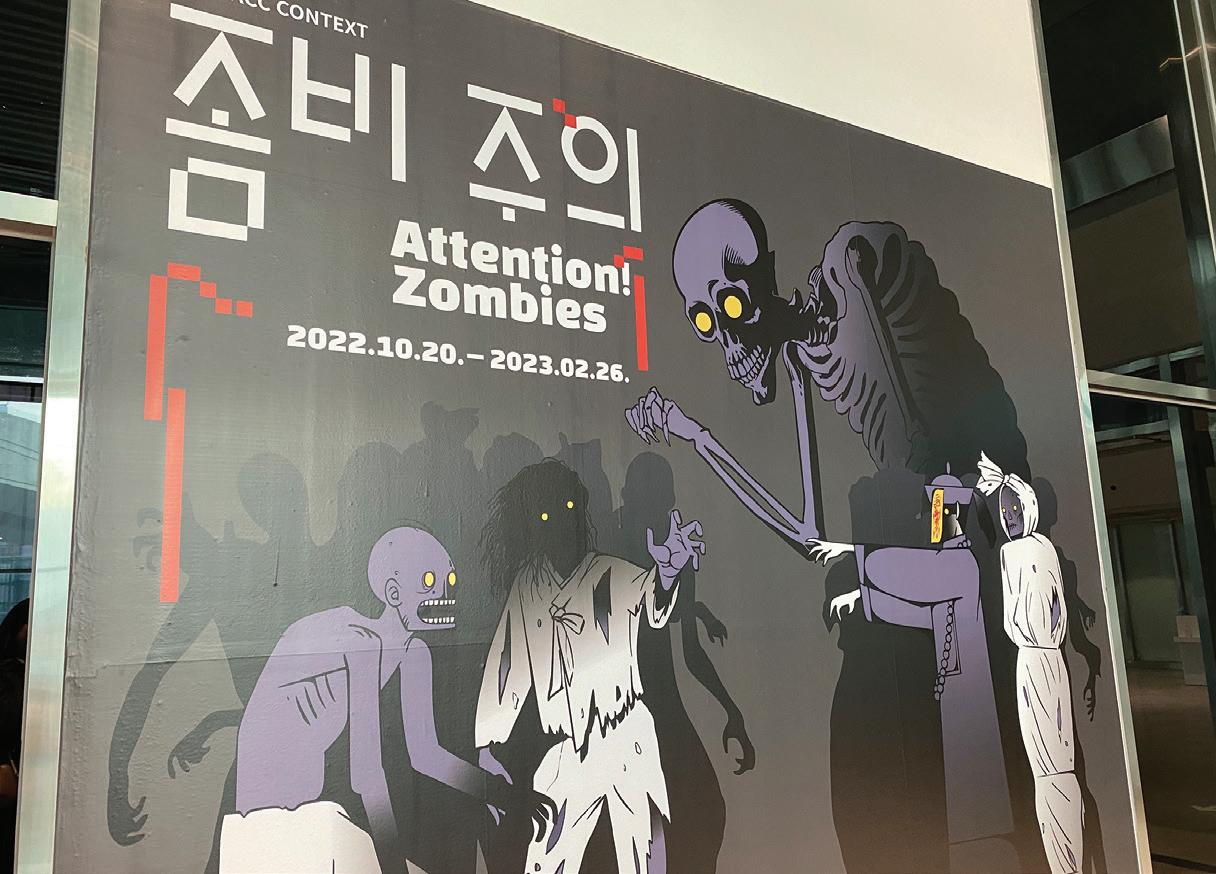
Matgol 맛골
Address: Yongju-ro 30-beon-gil, Buk-gu, Gwangju
광주 북구 용주로 30번길 27 Phone: 062-266-8621
Ilda 일다

Address: Uchi-ro 110-beon-gil, Buk-gu, Gwangju
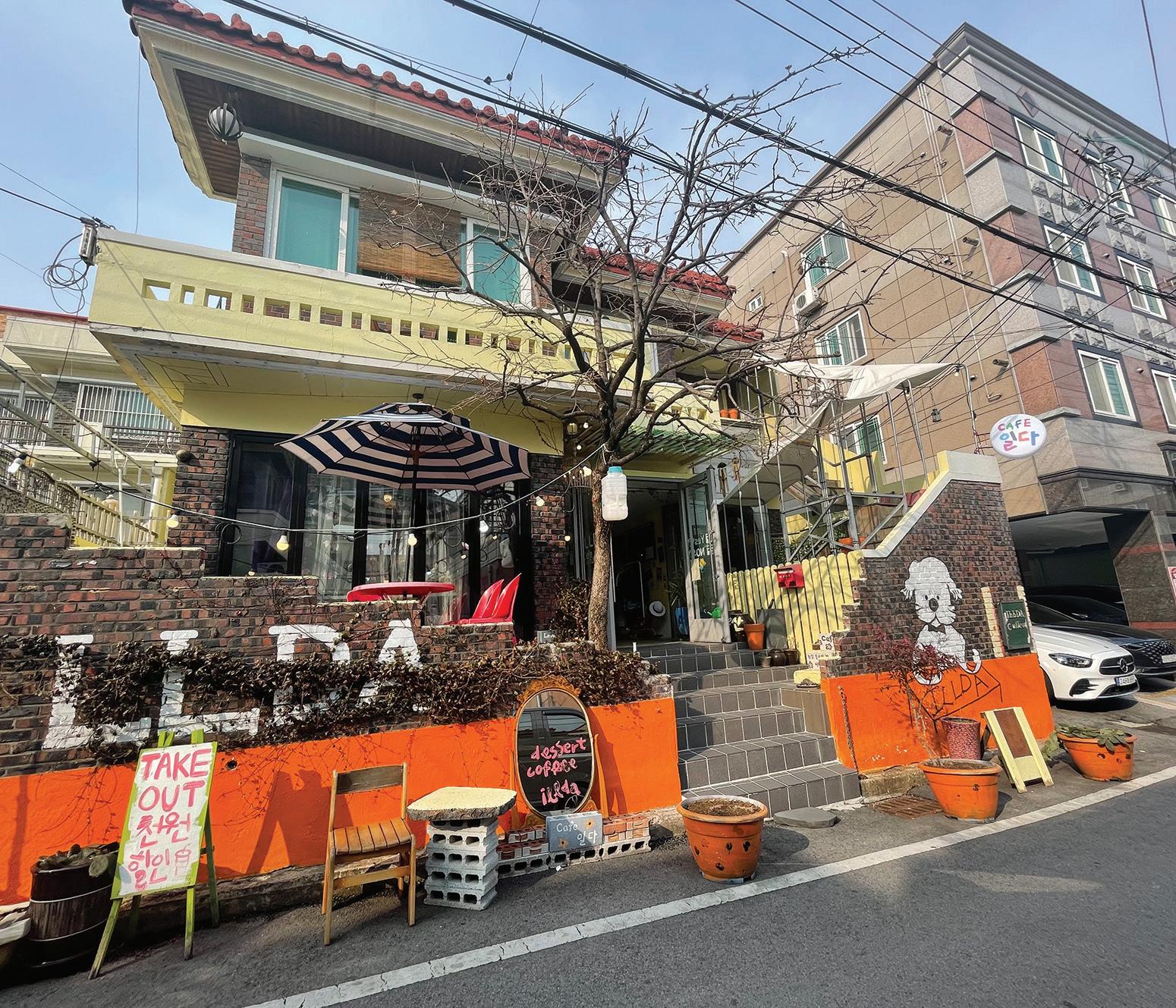
광주 북구 우치로110번길 43 Phone: 070-8898-8841
The Author
Gutema Saron Samuel is a CNU junior considering a career in biotechnology and bioengineering. She’s enthusiastic about anything related to academia. Two interesting things about her: She can shout a song at any moment, and she’s a movie buff. Instagram: @Saron_gutema
This style of cooking dubu (두부, tofu) was first presented to me on a platter-style salad dish at a nice restaurant in Busan about ten years ago. Since then, the recipe has spread around the peninsula, even to a part of a large hansik-style meal mixed with similarly lightly battered and fried mushrooms in a restaurant in the south of Cheonan.
The secret is, I think, to make the batter more of a light coating, rather than how we seem to like fish presented at some fish and chip shops in Aotearoa New Zealand: a heavy, overcooked shell almost strong enough to break teeth and deflect bullets. A lighter coating of just a little flour is quite enough to trap the heat and then the moisture within the dubu, making it fresh, crisp, but still also succulent and juicy, yet also hot and wonderfully tasty when served straight off the frying pan.
Dr. Neal Barnard’s Cookbook for Reversing Diabetes has another variation: simply baking blocks of tofu in an oven tray while soaking in a little low-salt soy sauce. Dr. Michael Greger’s book How Not to Die has a sequel called How Not to Diet, and that book has a companion cookbook; this includes a similar recipe using a lightly battered tempeh instead of tofu. Tempeh is increasingly widely available throughout South Korea. It has a firm texture and a strong flavor, whereas the almost jelly-like dubu tends to absorb tastes from the sauces in which it soaks before and while cooking.
The magic of dubu is its versatility: It goes well with any other food. However you prepare your dubu treat, you can also serve it alone or with your favorite
dish: stir-fried rice, noodles, and even with baked or fried potato wedges. It is cheap, easy to find, tasty when cooked creatively, has no cholesterol nor saturated fats, and, best of all, like all my favorite recipes, it is also wonderfully easy to prepare.
• A block or two of dubu = 450-600 grams
• Half a glass of soy milk
• Black pepper; red chilli powder
• Two-thirds cup of plain flour or corn meal
• Grapeseed or sunflower seed oil
• Optional: a cup of breadcrumbs
1. Turn on your oven to 170 °C or put a centimeter or less height of oil in a frying pan or wok.
2. Chop dubu into cubes large enough to hold between your chopsticks.
3. Place cubes on paper towels or a grill to dry a little.
4. Pour soy milk and powdered peppers into one bowl; put flour into a second bowl; put breadcrumbs into a third bowl.
5. Dip each cube of dubu and piece of mushroom in each bowl in that order, then place the cubes in an oven tray or frying pan.
6. Cook while turning every minute or two (or five to ten minutes in the oven), so they only start to go a very gentle golden brown.
7. Drain them on a wire grill or paper towel while serving the rest of the meal, then serve while still hot.
The Author Julian Warmington taught for twenty years at the university level in South Korea, half of which he spent in Gwangju. He established and ran the Busan Climate Action Film Festival, has given presentations internationally on teaching about environmental issues within ESL lessons and curricula, and misses visiting downtown Gwangju’s vegan buffet restaurant.

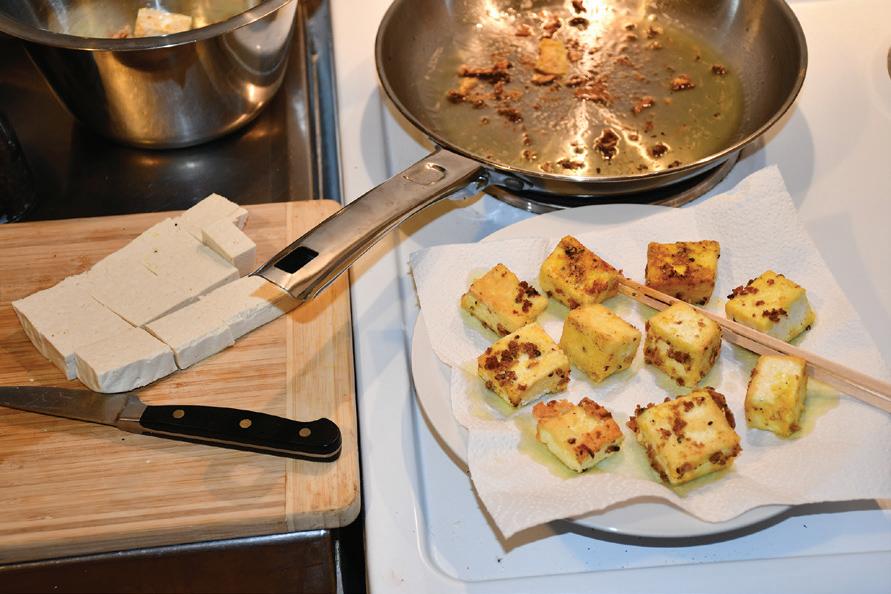




News,

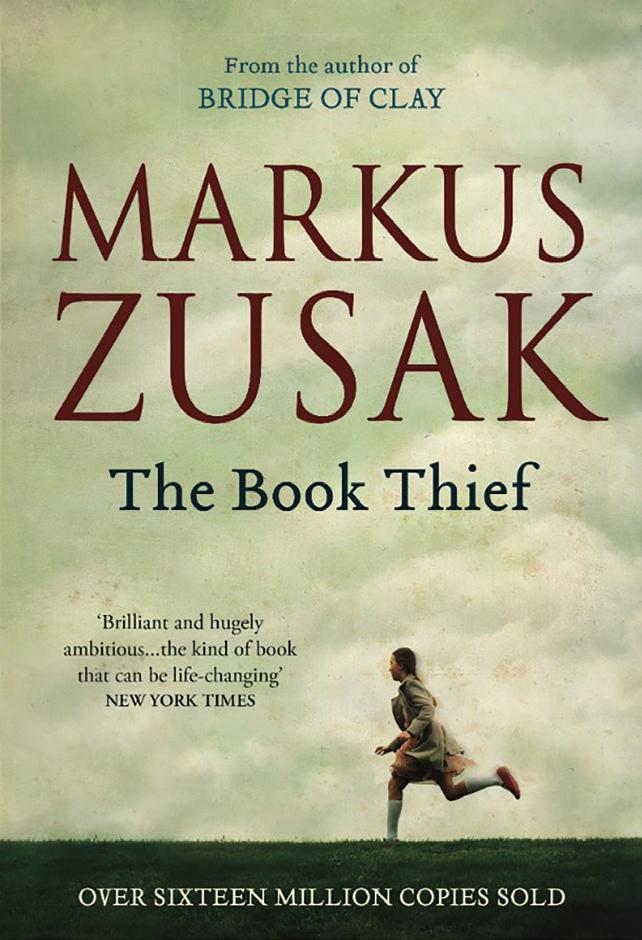 Reviewed by Michael Attard
Reviewed by Michael Attard
We meet Liesel Meminger just before her tenth birthday. It is January, 1939, not far from the German city of Munich. While traveling with her mother and younger brother, her brother dies. She is left with foster parents. She does not understand why her mother leaves her, but she had a sense of being saved. At her brother’s funeral, one of the grave diggers had dropped a book. Liesel picked it up. She could neither read nor write, but she kept the book, entitled The Grave Digger’s Handbook.
In the story, it becomes clear early that the narrator is “Death.” This distinctive form of storytelling creates a magical atmosphere which transcends what readers normally expect. The book is a war story, and Death is an appropriate entity to tell it. But the author does not paint Death as omniscient; rather, Death is an onlooker, puzzled and amazed by the extreme duality people exhibit. Death perceives human uniqueness in the thousands of colors that he sees in the sky, marking the places where he must go to gather the soul.
Liesel’s loving foster parents become Papa and Mama, and Papa was always there when she had her regular nightmares. Rudy, the boy next door, became her best friend. The characters are developed in detail. Even minor figures are described with a depth of keen observation twining them into an intricate part of the story, someone whom the reader cares about.
The author, through Death, makes use of metaphor. In describing Papa, he says of his eyes, “They were made of kindness, and silver.” Papa did not support Hitler. It does not take long for Liesel to conclude that her family’s problems stem from the Führer. At a bonfire to burn all the books that offend Hitler, Liesel retrieves a burning cover from the ashes and steals it away, almost secretly.
Unexpectantly, a man named Max appears and asks Papa if he still plays the accordion. Profound desperation is painted by the author: “The young man’s voice was scraped out and handed across the dark like it was all that remained of him.” The accordion is an often but subtly used metaphor throughout. As long as the accordion breathed, there was life. Max becomes Liesel’s friend. He is a Jew in hiding, and Liesel understands his plight. Death tells us that Max “breathed like a fugitive. Desperate yet soundless.”
Liesel purloins another book and, in a lighter mood, we watch her and Rudy, sometimes along with a group of boys, steal apples and potatoes. Although not crucial to the story, the fruit and vegetable thievery illustrates a lucid picture of kids being kids, even during a war, which highlights their unassailable humanness. At one point, Liesel and Rudy decide to work on their own without the gang. “Their plan was perfect but for one thing. They had no idea where to start.”
The war begins to get closer to home. People are “stripped of their living arrangements.” They often beg Death to take them with him. Death tells us that “some years, the souls and bodies don’t add up; they multiply.”
The stark contrast between human kindness and cruelty is the major theme of the book. Unforeseen changes in daily life begin to hone in more and more on the cruelty. Soldiers marched a parade of Jews through the town. Liesel hoped that “they could read the depth of sorrow in her face.” One old man, “weightless as he was, he was too heavy for his legs to carry.”
Another theme is the power of words. Liesel’s knowledge of this power is innate, and that is why she goes to the extreme of stealing books. She receives a few books as gifts, including one that Max writes for her. She learns to read well and comforts those in a basement sheltering from the falling bombs.
Papa and Rudy’s father are drafted into the army. Mama sat with the accordion and “Her fingers hovered above the keys.” Silence. “The keys were not struck. The bellows didn’t breathe.” A neighbor who returned from the fighting with a mangled hand that refused to stop dripping blood commits suicide. Then there is a reprieve. Papa breaks a leg and is sent home. “Yes, it was a great night to be Liesel Meminger, and the calm, the warm, and the soft would remain for approximately three more months.”
Death telling us that there will be calm for three more months is a foreshadowing. At various points, the author through Death reveals to us events that come later. Maybe this is a technique to keep the reader interested or engaged. It may also be used to portray the theme of mortality, specifically, the mortality of the reader. However, at the beginning of “Part Ten,” Death offers his own reasoning. “Again, I offer you a glimpse of the end. Perhaps it’s to soften the blow for later, or to better prepare myself for the telling.”
“The sirens were too late.”
The author of this touching historical fiction is Markus Zusak. Published in 2005, it has become a

bestseller, been translated into 63 languages, and sold 16 million copies. In 2013, it was adapted into a feature film.

Michael Attard is a Canadian who has lived in Gwangju since 2004. Though officially retired, he still teaches a few private English classes. He enjoys reading all kinds of books and writes for fun. When the weather is nice, you may find him on a hiking trail.





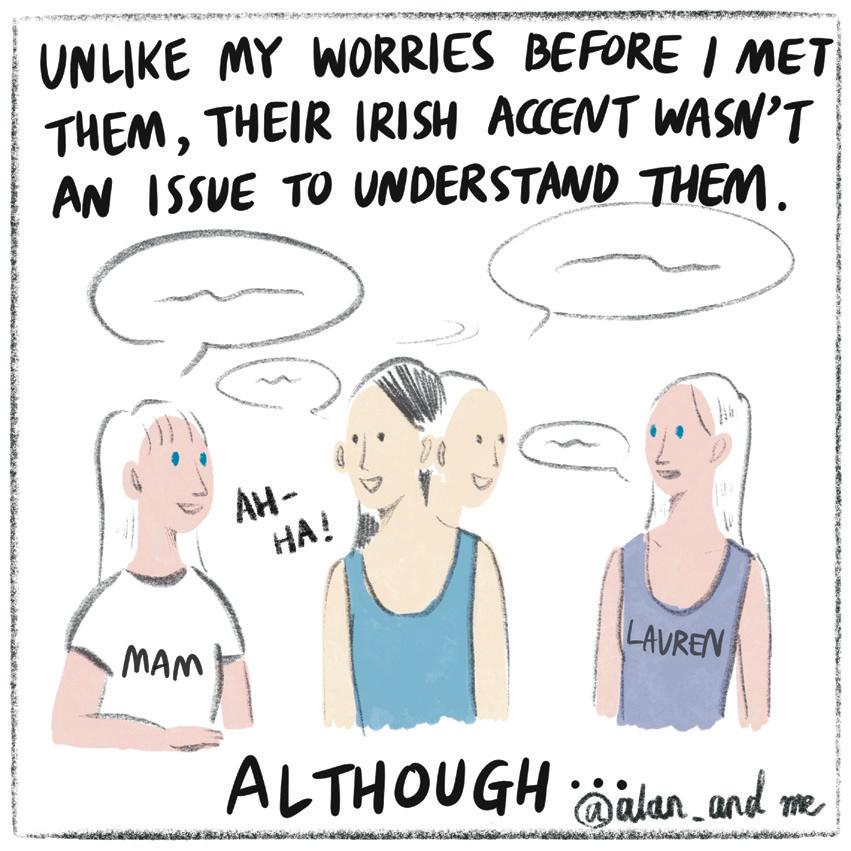

Yun Hyoju was born and raised in Gwangju, and somehow ended up married to an Irish guy named Alan. She has been working on her short comic, “Alan and Me,” which is about their daily life. She publishes a new comic every week on Instagram. It can be found here: @alan_andme.







April is home to four beautiful holidays in Korea: April Fools’ Day, Arbor Day, Easter Sunday, and April Nineteenth ProDemocracy Day. The month is almost like a tickertape parade of these holidays for throngs of curbside onlookers to feast their eyes on.
April Fools’ Day leads off this procession with little fanfare. It is an LOL party loaded with laugh riots, though. Everyone indulges in tons of innocent fun, making a fool of each other at no particular cost to anyone. And plenty of laughter piggybacks on the day’s fun fest. Given that laughter is the best medicine, April Fools’ Day is not just a fun day but a wholesome one as well. Whoever dreamed up this intriguing holiday must have been a genius with a beautiful mind.
Arbor Day follows April Fools’ Day by just four days. Dedicated to public tree planting, it is a true friend of the environment. It is still remembered for the legendary role it had to play in Korea’s acclaimed reforestation campaign of some sixty years ago. This storied national project owed most of its success to the entire country rising to the occasion with passion. Volunteers came forward in droves helping morph every nook and cranny of Korea from brown and bare to green and lush. Achieved in a relatively short span of time, this stunning feat was nothing short of a miracle.
In an unfortunate twist of destiny, though, we already need to turn to the Arbor Day playbook of yore for another round of all-out national reforestation. Our hand is forced this time around by the ever-growing threat of an imminent climate collapse.
As we ponder how best to deploy this Arbor Day blueprint, we would do well to take a look at some trend-setting urban centers of the world. We can begin by noting that they all have vast tracts of land set aside as their hearts and lungs. Washington,
D.C., has its Rock Creek Park; New York City has its Central Park and company; London has its “Royal Fleet” of parks, gardens, yards, and heaths; and Paris has its “Imperial Legion” of green urban oases.
The obvious takeaway for us here is this: Korea also may need to have a generous portion of its land area given over to forests. In undertaking this venture, however, we would be well-advised to take the long view and make haste slowly. It is always best to play it safe, no matter how urgent the mission may be.

Next up in the procession of April’s grand holidays is Easter Sunday. Honoring the day Jesus Christ came back to life from the dead, it is a bona fide holy day on par with Christmas itself at the very least. The Resurrection is truly the holiest red-letter day in all Christendom. No wonder the day is celebrated in grand style by Christians everywhere.
Last but not least, on the secular side of this equation is the tale of Korea’s April Nineteenth Pro-Democracy Uprising. A major milestone in the annals of Korean democracy, this heroic revolt is memorialized in much of the country to this day. Much to our regret, however, April Nineteenth was quite unceremoniously pulled off the list of legal holidays in early 1973. Shame on those responsible for this dastardly act of betrayal against all those brave young souls who laid down their precious lives so that democracy may survive and thrive in this country.
The AuthorPark Nahm-sheik has a BA in English from Chonnam National University, an MA in linguistics from the University of Hawaii at Manoa, U.S.A., and a PhD in applied linguistics from Georgetown University. He is now a Professor Emeritus after a long and illustrious career at Seoul National University as well as President Emeritus of the International Graduate School of English.
1 Early US electronics company
2 Top-left key
3 Kyung-bae or Do Ho
4 Piece of chicken
5 Gangjin has 188 of this
6 Freezes
7 Ponder
8 Big
9 “___ du lieber!”
10 West or Whitman
11 Butterfly or chart
16 Seonbi
19 Cuddling
20 Dongui ___
Look for the answers to this crossword puzzle to appear in May in Gwangju News Online (www.gwangjunewsgic.com). 32

